UPDATE 7/21/2021: As you doubtless know at this point, it was not over. Given the visibility of this post, I'm going to note here at the top that the prediction of a potential large wave of infections between March and May did not happen, no matter what ultimately happens with Delta (and the prediction was not made with Delta in mind anyway, only Alpha). Some more reflections on that at the bottom of this post here.
A year ago, there were reports coming out of China about a new coronavirus. Various people were saying things about exponential growth and the inevitability of a new pandemic, and urging action be taken. The media told us it was nothing to worry about, right up until hospitals got overwhelmed and enough people started dying.
This past week, it likely happened again.
A new strain of Covid-19 has emerged from southern England, along with a similar one in South Africa. The new strain has rapidly taken over the region, and all signs point to it being about 65% more infectious than the old one, albeit with large uncertainty and error bars around that.
I give it a 70% chance that these reports are largely correct.
There is no plausible way that a Western country can sustain restrictions that can overcome that via anything other than widespread immunity. This would be the level required to previously cut new infections in half every week. And all that would do is stabilize the rate of new infections.
Like last time, the media is mostly assuring us that there is nothing to worry about, and not extrapolating exponential growth into the future.
Like last time, there are attempts to slow down travel, that are both not tight enough to plausibly work even if they were implemented soon enough, and also clearly not implemented soon enough.
Like last time, no one is responding with a rush to get us prepared for what is about to happen. There are no additional pushes to improve our ability to test, or our supplies of equipment, or to speed our vaccine efforts or distribute the vaccine more efficiently (in any sense), or to lift restrictions on useful private action.
Like last time, the actions urged upon us to contain spread clearly have little or no chance of actually doing that.
The first time, I made the mistake of not thinking hard enough early enough, or taking enough action. I also didn’t think through the implications, and didn’t do things like buying put options, even though it was obvious. This time, I want to not make those same mistakes. Let’s figure out what actually happens, then act upon it.
We can’t be sure yet. I only give the new strain a 70% chance of being sufficiently more infectious than the old one that the scenario fully plays out here in America before we have a chance to vaccinate enough people. I am very willing to revise that probability as new data comes in, or based on changes in methods of projection, including projections of what people will decide to do in various scenarios.
What I do know is we can’t hide our heads in the sand again. Never again. When we have strong Bayesian evidence that something is happening, we need to work through that and act accordingly. Not say “there’s no proof” or “we don’t know anything yet.” This isn’t about proof via experiment, or ruling out all possible alternative explanations. This is about likelihood ratios and probabilities. And on that front, as far as I can tell, it doesn’t look good. Change my mind.
The short term outlook in America has clearly stabilized, with R0 close to 1, as the control system once again sets in. Cases and deaths (and test counts) aren’t moving much. We have a double whammy of holidays about to hit us in Christmas and New Year’s, but after that I expect the tide to turn until such time as we get whammied by a new more infectious strain.
Instead of that being the final peak and things only improving after that, we now face a potential fourth wave, likely cresting between March and May, that could be sufficiently powerful to substantially overshoot herd immunity.
Let’s run the numbers.
The Numbers
Predictions
Last week’s prediction: 13.1% positive rate on 11.5 million tests, and an average of 2,850 deaths per day.
Results: 13.7% positive rate on 10.7 million tests, with an average of 2,677 deaths.
We didn’t test substantially more people than last week, and the positive test percentage didn’t fall much, and the death rate didn’t rise much. Everything in a holding pattern. Some of that could be pending Christmas issues. Fool me twice, and all that.
This next week is Christmas plus New Year’s, so reporting issues are inevitable. Another week for wide error bars.
Prediction: 13.6% positive rate on 10.1 million tests, and an average of 2,500 deaths per day.
Note that I expect the deaths decline, at least, to be about reporting rather than about actual numbers, which I don’t think will start to decline much for a bit longer.
Deaths
| Date | WEST | MIDWEST | SOUTH | NORTHEAST |
| Oct 22-Oct 28 | 895 | 1701 | 2208 | 612 |
| Oct 29-Nov 4 | 956 | 1977 | 2309 | 613 |
| Nov 5-Nov 11 | 1089 | 2712 | 2535 | 870 |
| Nov 12-Nov 18 | 1255 | 2934 | 2818 | 1127 |
| Nov 19-Nov 25 | 1761 | 4169 | 3396 | 1714 |
| Nov 26-Dec 2 | 1628 | 3814 | 2742 | 1939 |
| Dec 3-Dec 9 | 2437 | 5508 | 4286 | 2744 |
| Dec 10-Dec 16 | 3278 | 5324 | 4376 | 3541 |
| Dec 17-Dec 23 | 3826 | 5158 | 5131 | 3772 |
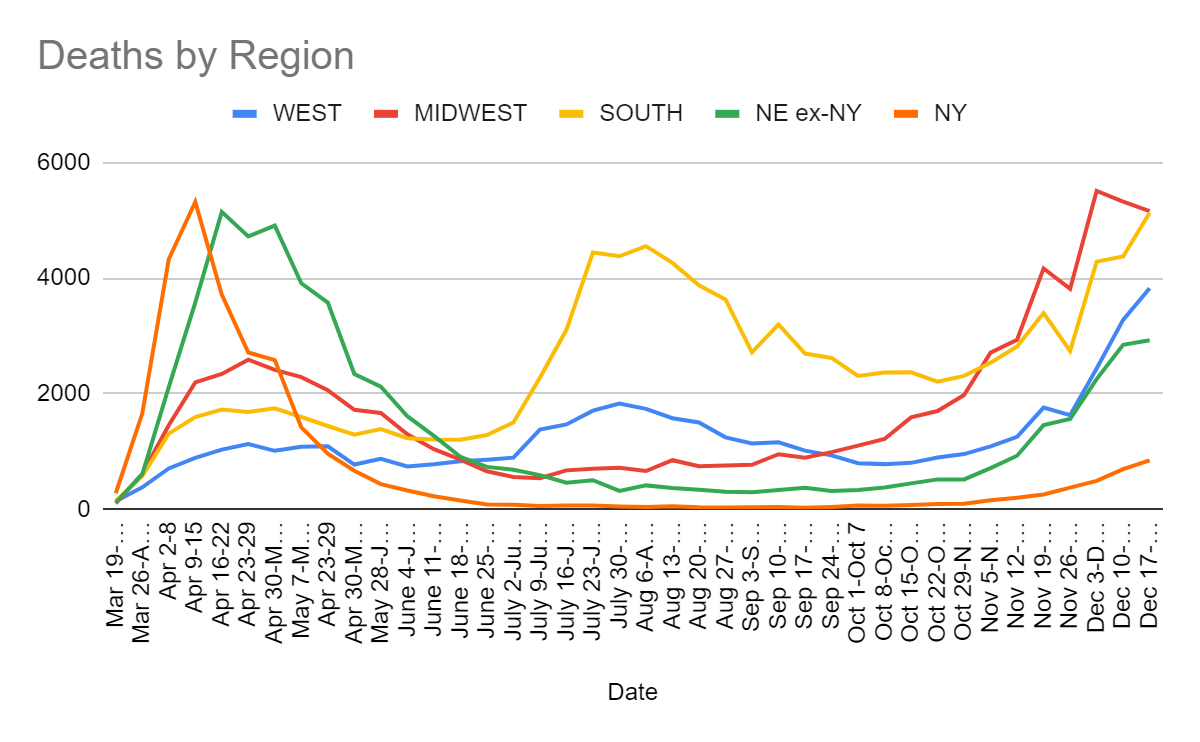
Death rates didn’t rise all that much due partly to the decline in the Midwest, but they are still up in the other three regions and substantially in the West and South. It seems clearly a few weeks too early to hit peak deaths based on when we had peak infections.
Going forward, the vaccine will start to be effective for those who get infected next week, so to the extent we are protecting residents of nursing homes, we’ll see that effect in the death rate start to be noticable in late January. I expect deaths to be in decline by then.
Positive Test Percentages
| Percentages | Northeast | Midwest | South | West |
| 10/22 to 10/28 | 3.68% | 9.87% | 8.58% | 6.46% |
| 10/29 to 11/4 | 4.28% | 12.79% | 8.86% | 7.04% |
| 11/5 to 11/11 | 5.56% | 17.51% | 9.89% | 8.31% |
| 11/12 to 11/18 | 6.99% | 18.90% | 11.64% | 10.66% |
| 11/19 to 11/25 | 7.00% | 16.62% | 10.41% | 11.75% |
| 11/26 to 12/2 | 8.38% | 17.90% | 12.45% | 12.79% |
| 12/3 to 12/9 | 10.47% | 17.94% | 13.70% | 12.76% |
| 12/10 to 12/16 | 10.15% | 15.63% | 15.91% | 13.65% |
| 12/17 to 12/23 | 9.88% | 14.65% | 15.78% | 13.82% |
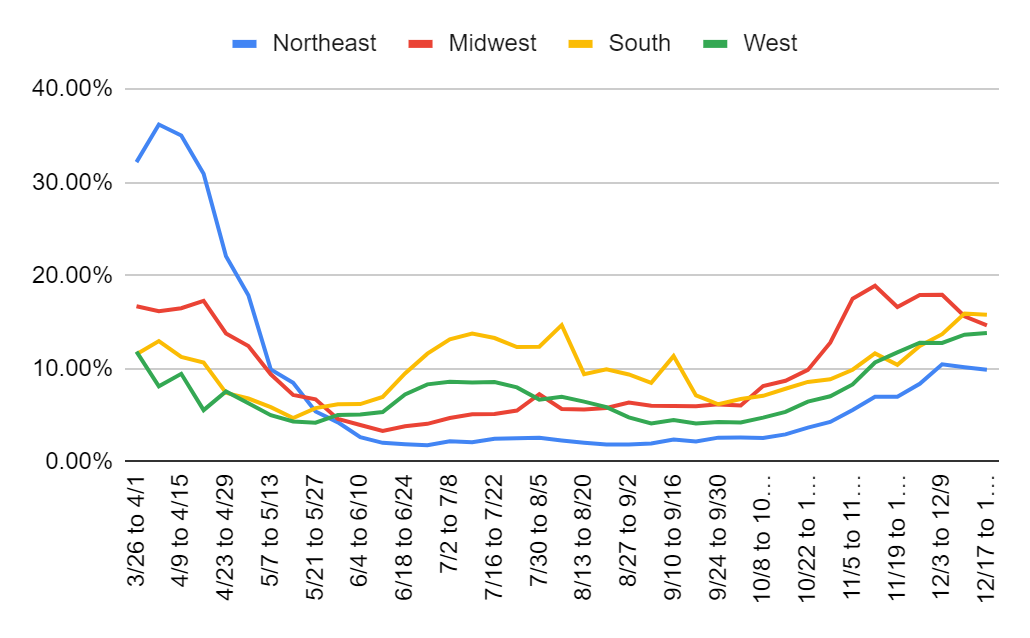
Quiet on all fronts. Midwest clearly in slow decline, looks like other regions also ready to follow, as soon as we get past the holidays. There’s also an overall one-time bump coming of unknown size, but after that we should be clear until the new English or South African strain becomes a problem.
Positive Tests
| Date | WEST | MIDWEST | SOUTH | NORTHEAST |
| Oct 22-Oct 28 | 94983 | 181881 | 158123 | 57420 |
| Oct 29-Nov 4 | 112684 | 252917 | 167098 | 70166 |
| Nov 5-Nov 11 | 157495 | 387071 | 206380 | 108581 |
| Nov 12-Nov 18 | 211222 | 452265 | 255637 | 150724 |
| Nov 19-Nov 25 | 269230 | 435688 | 294230 | 170595 |
| Nov 26-Dec 2 | 256629 | 357102 | 294734 | 185087 |
| Dec 3-Dec 9 | 354397 | 379823 | 368596 | 263886 |
| Dec 10-Dec 16 | 415220 | 315304 | 406353 | 260863 |
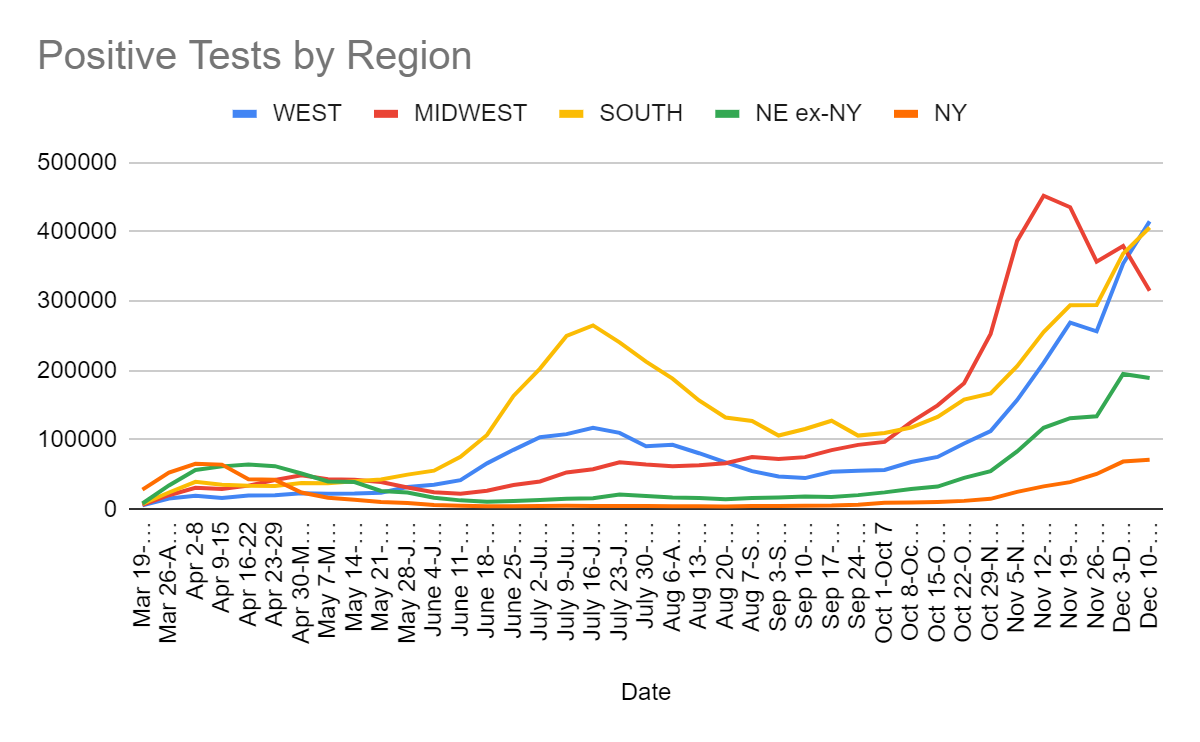
Also, this seems like a nice graphic:
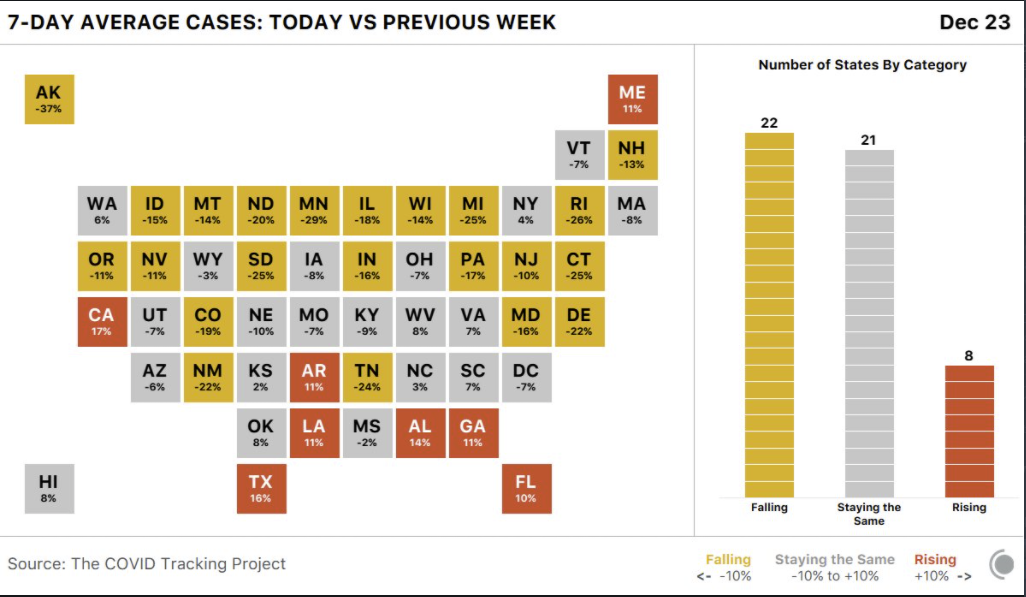
But it’s also potentially misleading, because the increased cases in the deep South are mostly increased testing. The California increase is largely real. It would make sense that California would be the place that has stalled its crisis for the longest, between not having cold weather and imposing draconian restrictions all year, and so perhaps it’s finally time for them to face the music.
Test Counts
| Date | USA tests | Positive % | NY tests | Positive % | Cumulative Positives |
| Oct 15-Oct 21 | 6,461,028 | 6.4% | 865,890 | 1.2% | 2.52% |
| Oct 22-Oct 28 | 6,943,470 | 7.5% | 890,185 | 1.4% | 2.67% |
| Oct 29-Nov 4 | 7,349,648 | 9.5% | 973,777 | 1.6% | 2.89% |
| Nov 5-Nov 11 | 8,285,878 | 10.7% | 1,059,559 | 2.4% | 3.16% |
| Nov 12-Nov 18 | 9,033,621 | 12.4% | 1,155,670 | 2.9% | 3.50% |
| Nov 19-Nov 25 | 10,415,393 | 11.8% | 1,373,751 | 2.9% | 3.87% |
| Nov 26-Dec 2 | 9,741,057 | 11.7% | 1,287,010 | 4.0% | 4.22% |
| Dec 3-Dec 9 | 10,458,644 | 13.9% | 1,411,142 | 4.9% | 4.66% |
| Dec 10-Dec 16 | 10,694,845 | 13.8% | 1,444,725 | 4.9% | 5.11% |
| Dec 17-Dec 23 | 10,710,356 | 13.7% | 1,440,770 | 5.1% | 5.56% |
This is the silent scandal no one is talking about. Why are we no longer expanding testing? It seems clear now that our capacity hasn’t been expanding in December. It’s clear that demand greatly exceeds supply, and that more testing would be a huge help. When things were improving slowly, at least they were improving. Now it looks like we are stalled out, well short of where we need to be. Vaccinations are important, but until we get a lot farther along on those, so are tests.
Covid Machine Learning Projections
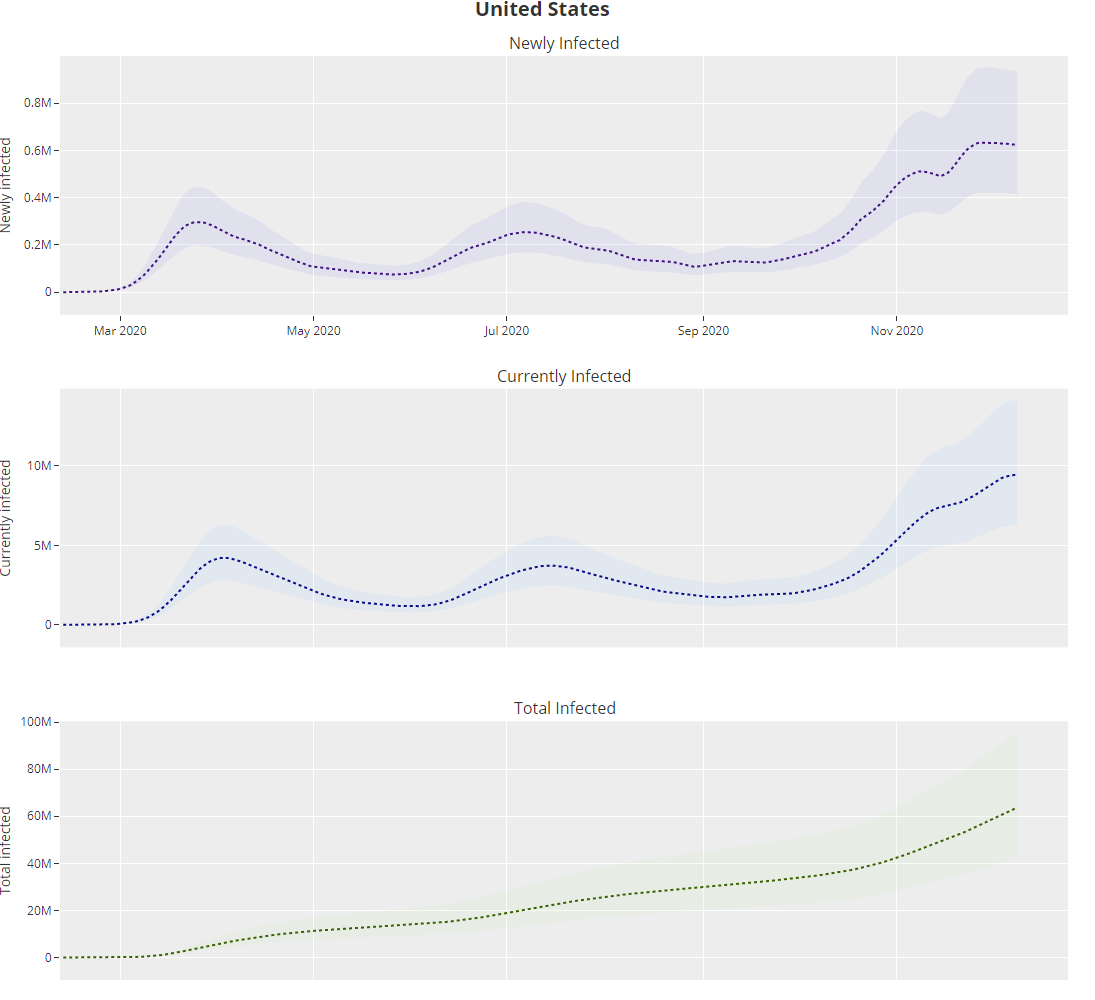
Machine learning projections say infections have been static since about November 25, which mostly matches the testing data. We can assume that the projections will keep saying similar things for the next two weeks.
Their predicted total infected is up to 19.2% on December 9, stabilized at 623k new infections per day. The total is up from 17.9% on December 2. As a reminder, I consider these lower bound estimates.
The immunity effects here compound fast. Even if you assume people get infected completely at random, going from 17.9% to 19.2% immune reduces R0 by 1.6%, which reduces infection levels by that much every five days or so, or 9% per month, and we’re introducing that effect permanently each week. After a month of this level of effect, you’ll see a 16% decline from newly immune people alone. After two months, infection levels would be cut in half.
Selection of who gets infected makes the effect bigger, and also we get to add vaccinations.
Of course, the control systems ensure it does not work that way, as people will notice things improving and take more risks, but it’s worth noting that things will start rapidly getting better if we can only hold onto our current levels of prevention, and let immunity from all sources do the job from there.
Europe
Going to use short-dated graphs to improve readability. If you want the longer view you can get it at OurWorldInData, or previous weekly Covid posts.
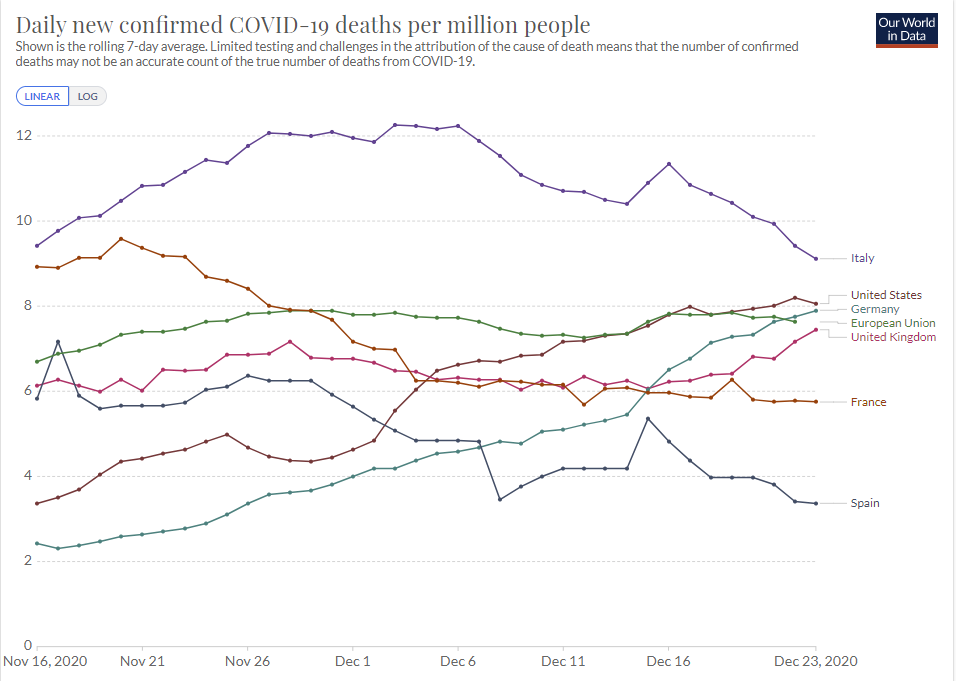
Sh
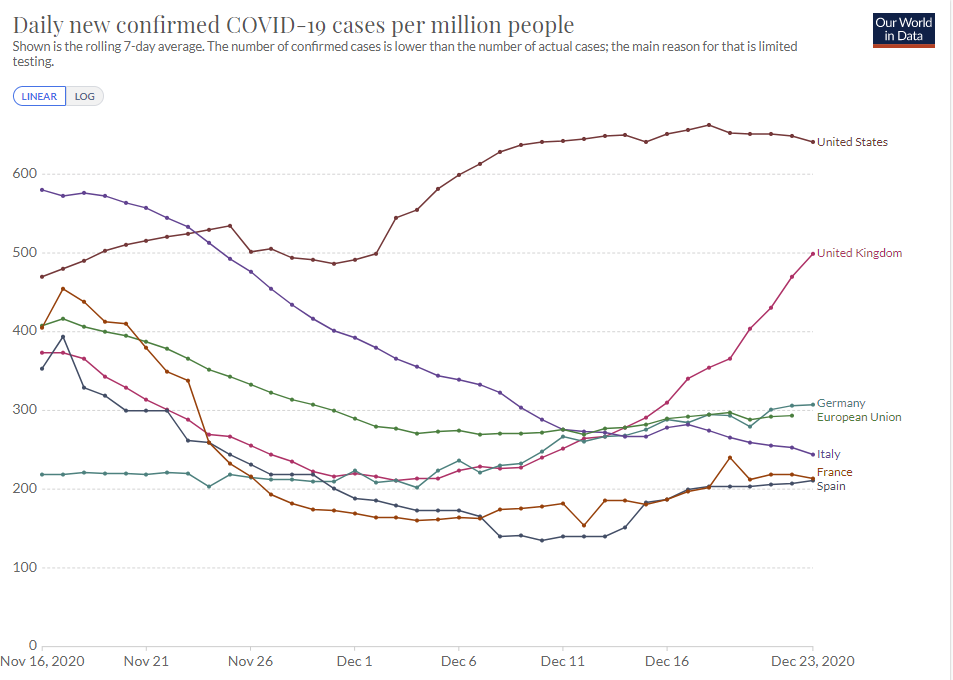
The positive test percentages chart is so incomplete and all over the place that I’m going to stop posting it, but you can go to the source if you still want it.
Deaths in Europe continue to run close to those in the United States, suggesting the Europeans are finding cases less often than we are, or have worse medical care or are worse at protecting vulnerable populations.
Then there’s that United Kingdom graph going rapidly vertical in infections. Turns out, there’s a reason, and it’s not that they lifted their restrictions…
The English Strain
The big news this week is that England has identified a new strain of Covid-19 that is ‘up to 70% more infectious’. The new strain dominates in southern England, including London, and the graphs tell a rather clear story.
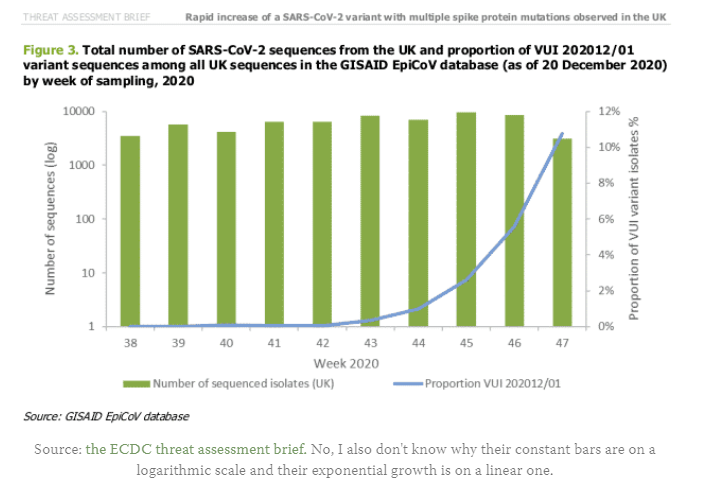
Oh no.
You’re probably wondering the same question I was when I read that, which is that we know that ‘up to’ means we’re not willing to commit to anything at all (did you know I am up to 15 feet tall? It’s true!), but what the hell does ‘70% more infectious’ mean?
It could mean a lot of different things.
To me, there are two natural hypotheses for what it means.
One sensible definition of this is that 70% more people get infected each day, so it raises R0 by that percentage. If previously things were stable, 70% more infectious would cause infections to rise 70% each serial interval, which I’ve been approximating at about five days. So if it was this, things would about double each week.
Alternatively, it could mean that any given physical interaction was 70% more likely to infect you. This seems unlikely to be it, because how would anyone know what this value was, but it still makes at least some intuitive sense and has some practical value. So if before, if you went home for Christmas and someone was infected, you’d have a 10% chance of getting Covid-19, now that number is 17%.
The difference between those two is that if you get exposed multiple times, you can only get infected once, so the first scenario is a bigger jump in cases than the second one. Depending on how much ‘overkill’ you think takes place when people get infected, the difference could be big or it could be small.
As a third option, it could mean any given exposure is effectively as if you were exposed to 70% more virus. Chance of catching the virus is non-linear with viral load, so in some ways this is a more than 70% increased risk (if previously load was below threshold to get infected, and now it isn’t), and in other ways it could be less once you get to the other end of the curve. This also changes the distribution of initial viral loads, in ways that might be good or bad for outcomes and death rates. If you are reliably getting higher initial loads, that’s bad. If you are getting infected despite low loads then, given that we know you’re infected, that’s good, perhaps quite good.
What I definitely didn’t consider was the possibility that this was measuring the length of the doubling time because that’s not remotely a fixed number and using this doesn’t make any sense and arrrrrgh and then I saw this on this post:
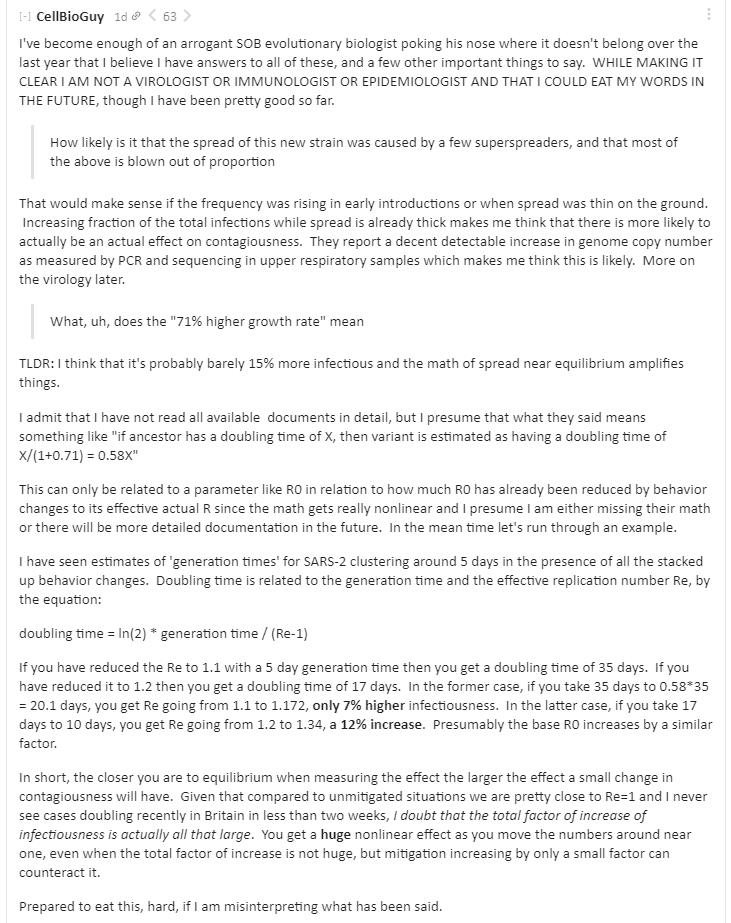
What is still driving me crazy is that CellBioGuy presumed that this was what they meant. I mean, I certainly hope it is what they meant in terms of ‘that physical property of the world would kill less people’ but I can’t help but notice it would be completely insane in a way that even my model of predicted general insanity isn’t handling well. The model isn’t even handling the presumption by CellBioGuy very well here.
So it turns out that CellBioGuy was wrong here, and this refers to the sensible thing of “percent rise in infections each cycle” R0 thing:
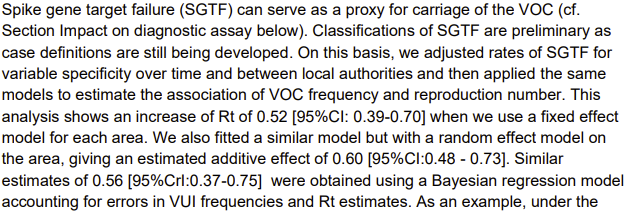
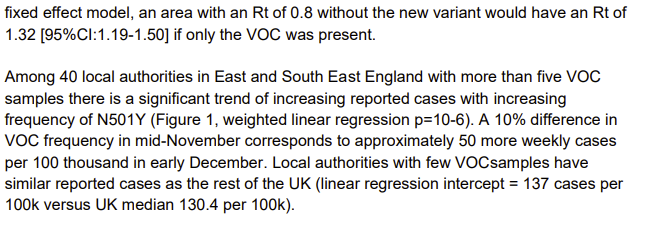
(Do check out the rest of that comment by CellBioGuy anyway – even though the presumption in question turned out to be wrong, the rest of the comment has a lot of good gears-level details on various issues, but it’s too long to put here in full. I’d like to know how well the rest holds up.)
So on the plus side, statistics are being reported in a way that is relative sane.
On the minus side, this seems rather like it can be summed up as: We’re fucked, it’s over.
This is estimated as a 65% increase in infectiousness. If we want to stabilize infections in an area that was previously stable we’d need what would previously have been an R0 of about 0.6. If you have an R0 of 0.6 that means you would have previously been cutting infections in half each week or so.
Does that sound like something any Western country could possibly accomplish from here? What would even trying to do that even look like? Is there any chance people would stand for what was necessary to do that?
And that’s only what it takes to get a holding pattern.
Under such dire circumstances, a phase 4 lockdown has been invoked. What does that mean? Glad you asked, here are the guidelines.
The missing restrictions that stick out are not shutting down houses of worship, and allowing people to move house. Also funerals can go up to 30 people, whereas weddings are capped at 6. Also ‘support groups’ can meet up to 15 people and I don’t see anything saying it needs to be outdoors.
Whereas essentially any social contact of any kind is forbidden (e.g.: “You cannot meet people in a private garden, unless you live with them or have formed a support bubble with them”), your ‘bubble’ is highly restricted in its sizing, and you’re not allowed to be outside without a ‘reasonable excuse’ although those include groceries, going to the bank or exercising.
So basically, if you’re outside where it’s safe, they’ll harass you and maybe worse. Whereas if you stay inside, technically it’s not allowed but in practice it’s a lot less likely anything happens to you, unless the anything in question is ‘you catch Covid-19.’ The rules are porous enough that they aren’t enforceable against the things that are risky but enforceable enough to shut down the relatively safe actions that keep people sane. And with weird exceptions for remarkably large indoor gatherings for certain events that are textbook superspreaders.
All of which is what our model expects to see, and none of which seems likely to be remotely sufficient if the new strain is as infectious as they estimate.
The strain has already been seen in several other countries. Flights between the United States and the United Kingdom have not been shut down. Many European countries are shutting down some travel, which will slow things down a bit, but headlines like this one…

…illustrate that slowing things down is all that’s being aimed at. Which is good, because it’s too late anyway. There would not be any drivers to test if this was a real attempt at containment.
If the estimate of 65% more infectious is correct: The strain doubles every week under conditions where other strains are stable.
My father sent me this video (24 min) that makes the case for all of this being mostly a nothingburger. Or, to be more precise, he says he has only low confidence instead of moderate confidence that the new strain is substantially more infectious, which therefore means don’t be concerned. Which is odd, since even low confidence in something this impactful should be a big deal! It points to the whole ‘nothing’s real until it is proven or at least until it is the default outcome’ philosophy that many people effectively use.
Note that he also suggests the new strain is likely to be less virulent, and make us less sick, which could also be part of why it’s more infectious. If so, that’s great news (I can think of a scenario where it is actually bad news, but it’s an unlikely corner case).
He also points out correctly that a lot of nations don’t do much sequencing, so we should assume the new variant can’t be contained to England at this point. Doesn’t mean we shouldn’t try in order to slow it down, but such efforts will still fail.
The video seems strong on the scientific details, and the speaker strikes me as an excellent explainer/teacher, which is why I’m willing to link to it.
Alas, as is often the case with academics that are good at learning and explaining scientific things, the epistemology is bonkers. His core argument is: “You cannot use epidemiological data to prove a biological property.” With a side of Covid-19 being spread mostly by super-spreaders (true) and thus the new variant could be winning at random.
All of which is not how knowledge or Bayes’ rule works. It’s not how any of this works.
There is a valid point here, of course. Relying solely on the numerical growth of the strain or of infections in England generally, without looking at the context, doesn’t provide that much evidence. There are often other explanations. And his points about mutation in and of itself being commonplace and mostly harmless are well taken.
That doesn’t change that evidence is evidence, and a likelihood ratio a likelihood ratio. Experiments are not some special class of thing that are the only way one can make predictions or assign probabilities, and it’s weird that people can be so good at academic scientific thinking while not understanding this, and in fact it seems that when we train people to do academic science we also train them to not think about other information and to be careful not to use Bayes’ rule and to ridicule anyone who tries to use non-academic information in order to know things.
With that in mind, we look at the evidence and think about possible explanations, and mostly I find that there aren’t other plausible ones worth assigning much weight to.
Let’s start with those charts above. They aren’t quite this:
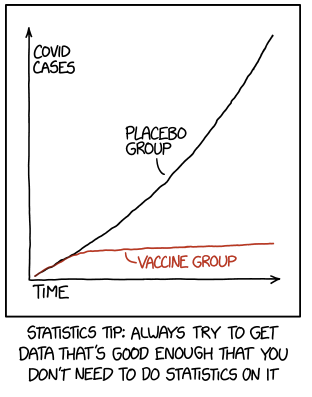
But then again, when you consider the context of England being under lockdown conditions that had previously turned the tide, and that have stabilized the situation elsewhere in Europe…
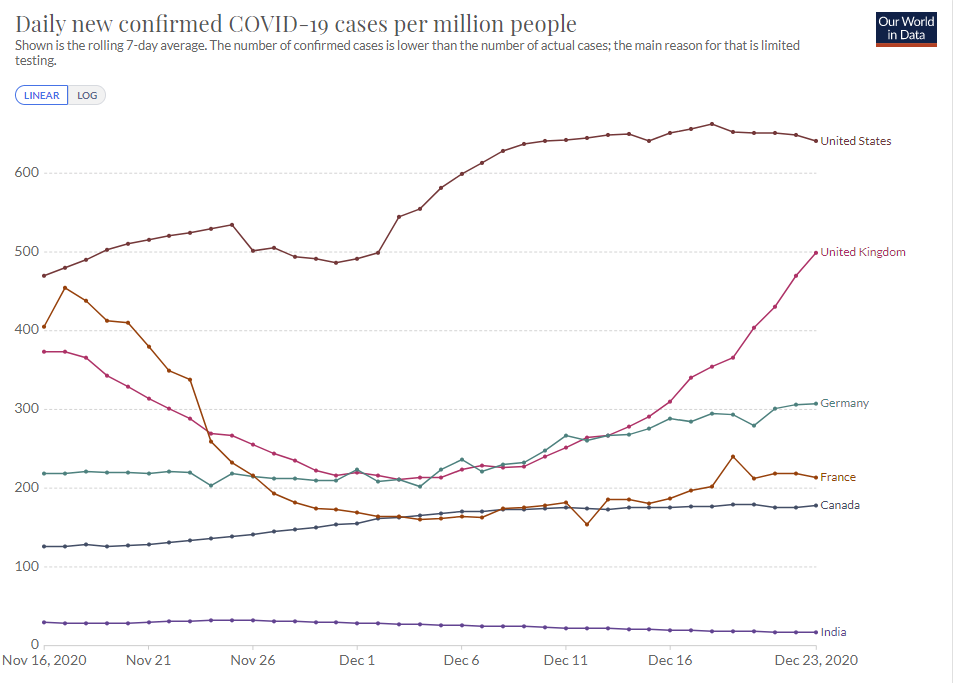
And combine it with the share of infections from the new strain from the earlier chart, and work out what those combine to imply…
This definitely does qualify under “hot damn, look at this chart.” This is a huge, dramatic increase in infections happening very quickly. A doubling in one week.
Note also that the warnings went out to the public on December 19. The out-of-sample data from the next few days strongly reinforce the hypothesis that we’re screwed.
The other plausible causes of such a rapid rise are not present. England didn’t suddenly relax its conditions this much. The law of large numbers is more than sufficient to make me very dismissive of ‘random chance via superspreader events’ as an explanation. How big are these superspreader events?
If my understanding of the situation is correct, there is only one conclusion:
This variant cannot be stopped short of mass vaccinations. It is not going to be stopped short of mass vaccinations.
All that is left is a holding action. Realistically, we can’t make enough of a dent to turn the tide of cases of the new strain until at least May. That’s about twenty weeks from now. That’s twenty doublings. So for every case that’s escaped to the United States so far, we can expect (does quick math) a million cases. Then another few doublings in June and July.
I do think we can do better than that, because it appears the tide is starting to turn now on the old strain, we’ll get a bunch of incremental help from increased immunity along the way, and control systems will set in.
But mostly, it seems like if you have vaccines and people who don’t want to die, you might want to hurry. I’ll get back to gaming the scenario out in the conclusion section.
(This prediction is repeated at the end of this post.)
All I Want For Christmas is a Covid Vaccine
Track it here.
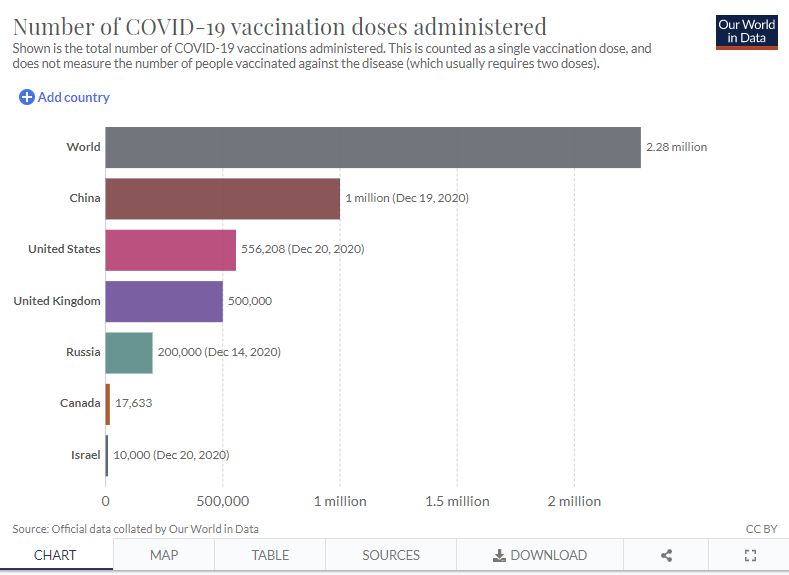
Or at Bloomberg here.
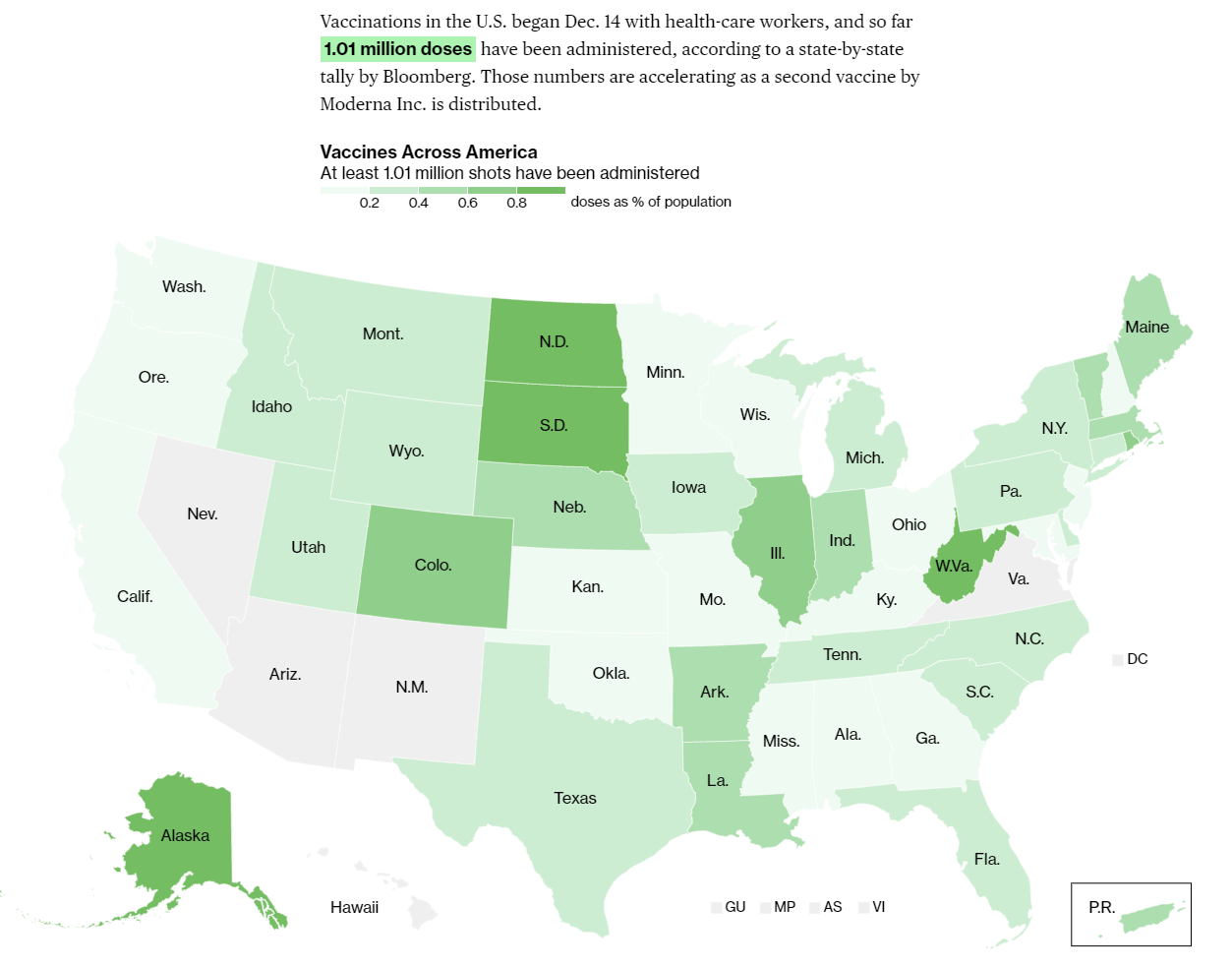
So, then, about that vaccine effort. How goes the distribution of the vaccine? Well (Twitter video link), funny story…
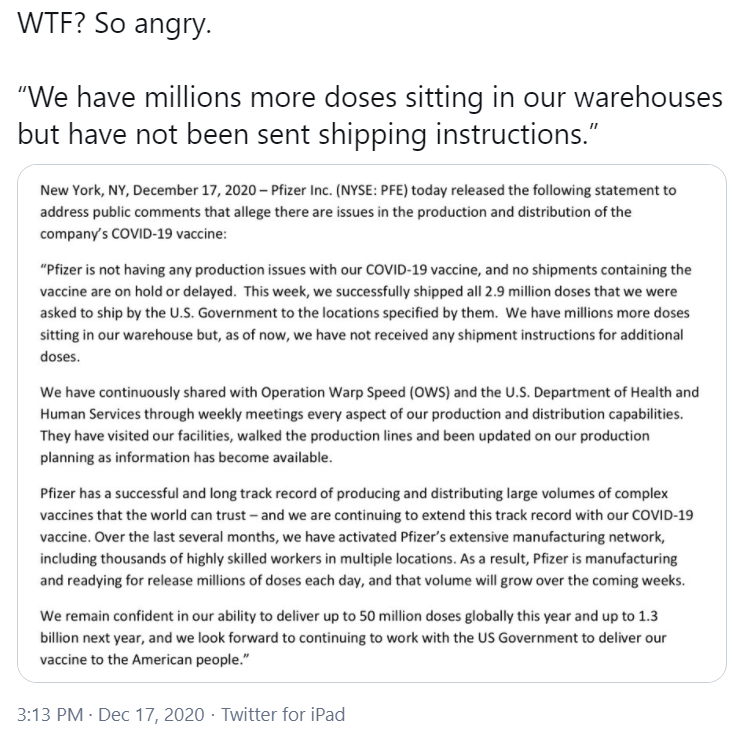
From CNN:

It seems that Pfizer executives are sitting around baffled that they have millions of additional doses of vaccine, and those doses are sitting on shelves unused, with continuous risk of spoilage, while they help no one. We have confirmation that this is explicitly not holding back second doses, and is coming as a complete surprise to Pfizer.
As a reminder, using a few million additional doses will cut infections by about 1% compounding each week, if distributed at random. If used selectively, an extra few million can cause a double digit drop in the death rate a month out, due to how concentrated deaths are among the elderly.
Distinctly from the issue of vaccine going to waste, the estimates given to states were too high, for which (Twitter video link) the head of Operation Warp Speed has taken responsibility. Such admissions are so virtuous and unexpected that they are clear signs of competence and trustworthiness. I agree strongly with Alex Tabarrok here, and my esteem for those involved went way up rather than down.
Oh, and also:
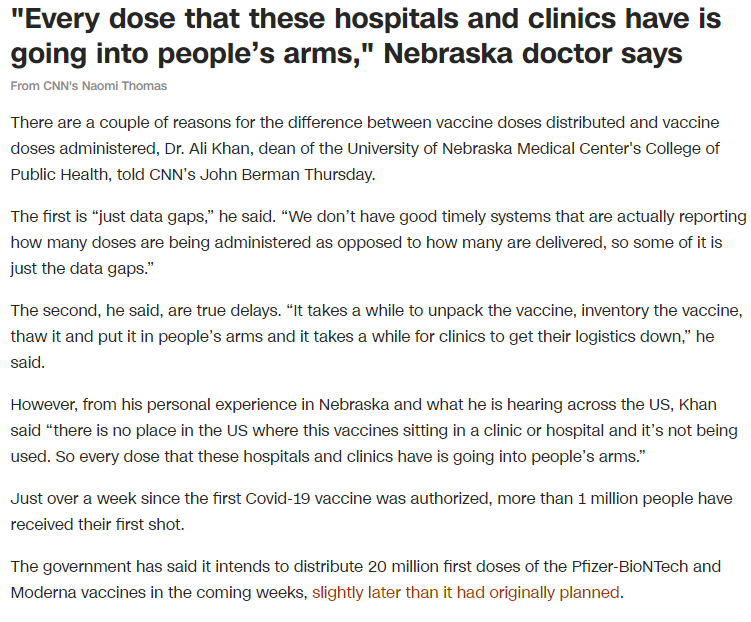
Versus:
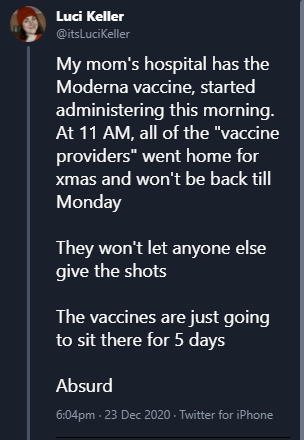
So there’s that. While regular folk are told to cancel the holidays. Merry Christmas, suckers.
Still, CNN again:

If true, that would be two weeks behind schedule, but assuming all of this is on a different track than manufacturing, so long as the process doesn’t keep falling further behind, I guess it’s not actually so bad? That’s a big ‘so long as.’ But it’s a plausible one, as initial difficulties don’t have to translate into difficulties once things are running and it’s not Christmas.
Then there’s the issue of that second dose. The science behind why you need two doses is strong and makes sense, except for the little matter of the data. It’s clear that the first dose alone is much more than half as effective as two, and we don’t have enough doses. And the first thing I asked when I saw that result was something that is once again being pointed out. Booster shots do not have to be given two weeks after the first shot. The measles booster comes a year later. Multiple sources confirm that there is no reason to expect a six-months-later second dose to be any less effective a booster.
We are mostly wasting an entire half of our vaccine supply by dosing exactly the worst people with it – the people who got the first dose. I can see double dosing those in nursing homes anyway, because they’re 1% of the population and over a third of deaths, so even a small additional boost is still worthwhile, and their immune systems are weak so it’s reasonable to worry the first dose alone won’t get the job done there. But beyond that, there’s no excuse I can see beyond saying the rules are the rules.
Here’s where we are, it seems:
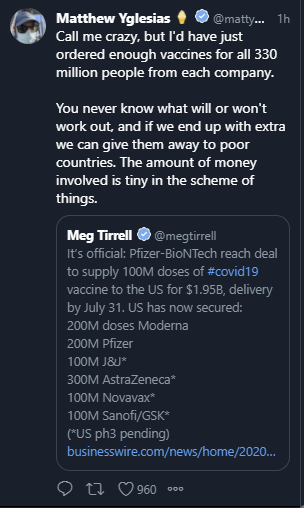
Doses that arrive on July 31 are not doses I expect to prevent many infections. And this total does not leave much margin for error, we barely have enough doses if we don’t use AstraZeneca and insist on everyone getting two shots.
How goes the vaccine quest elsewhere?
In Germany, not so well.
A real case can be made that, given our inability to do suppression properly, a Western government’s policy ends up mostly coming down to their effect on the vaccination schedule. Did they advance vaccine research?
On those fronts, we come out well ahead of the European Union. Does anything else matter by comparison? And how did we manage to do that?
Casey Mulligan reminds us that one of the things Trump has been doing for a while is getting the FDA to kill less people by speeding up and streamlining its processes. So when the time came for Operation Warp Speed, the concept was shovel ready. The “experts” all said eighteen months minimum and the “experts” got ignored. We certainly could have pushed much harder much faster, even given initial conditions. I’m not going to stop pointing that out. The decision to balk at buying extra doses might be the worst single decision of the last four years, of any kind. But when I model alternative administrations, from either tribe, I model a much slower vaccine effort. When we reach the end, it’s not clear that won’t matter more than every other decision combined.
In England, it seems they are going to be testing a vaccine grown using tobacco plants? Approval to begin trials is in. This seems like a great illustration of our regulatory state, because you can’t take the life-saving vaccine they grow with the tobacco plants, but you can take the tobacco in your pipe and smoke it even though we know it kills you. Okay, then.
Theoretical Vaccine Auction
If you want to properly allocate a scarce resource like a vaccine, obviously you use an auction. I said it last week, people righteously said that things are not worth to the customer what the customer will pay for them because poor people have less money than rich people, and no, sorry, that’s not how this works, that’s not how any of this works.
The good news for those who disagree is that there is not the slightest danger of any attempt at an efficient allocation of the vaccine.
Externalities, on the other hand, are definitely real. To the extent that they are different for different people, we should take that into account. In theory, an auction can do that because others can subsidize the bids of those whose vaccination is beneficial to them. In a first best situation lots of people would subsidize lots of others near them and the government at various levels would also supplement bids, but presumably people mostly won’t get such acts together and it won’t happen except highly locally, inside families and corporations.
My guess is that for all the talk of externalities, they’re not that different for different people other than those who were previously being irresponsible, and subsidizing them for that seems like it has some large moral hazard issues plus the worst offenders probably already had it. The exception would be those that provide a lot of value if they can expose themselves to the virus that they couldn’t otherwise, but are not being paid for that service enough to place the bids themselves. Health care workers in hospitals likely quality, but you can fix that if you subsidize the hospital to bid for them, and generally that class of solution seems like it should work.
Thus, the obvious solution of “N-lot, pay N+1th-highest-bid auction that repeats every so often” seems like it’s just correct on first principles, and then once you run the first one likely you can slowly reduce price to keep supply and demand balanced without having to go through all the trouble of more auctions?
So that’s not that interesting a paper and also it’s about four lines long, so it was odd when I followed a Marginal Revolution link to this paper about how to auction off the vaccine only to find a much longer paper.
Which goes on to suggest this:
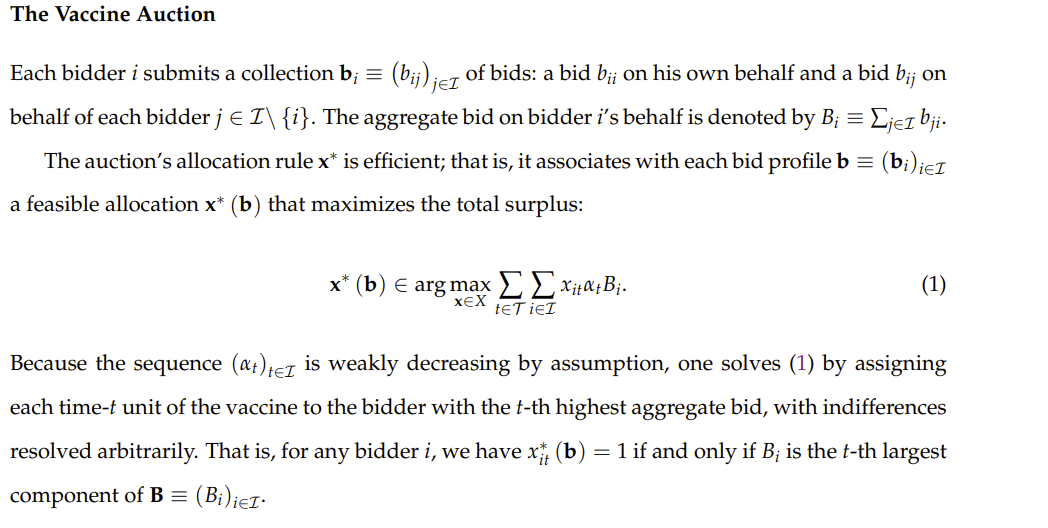
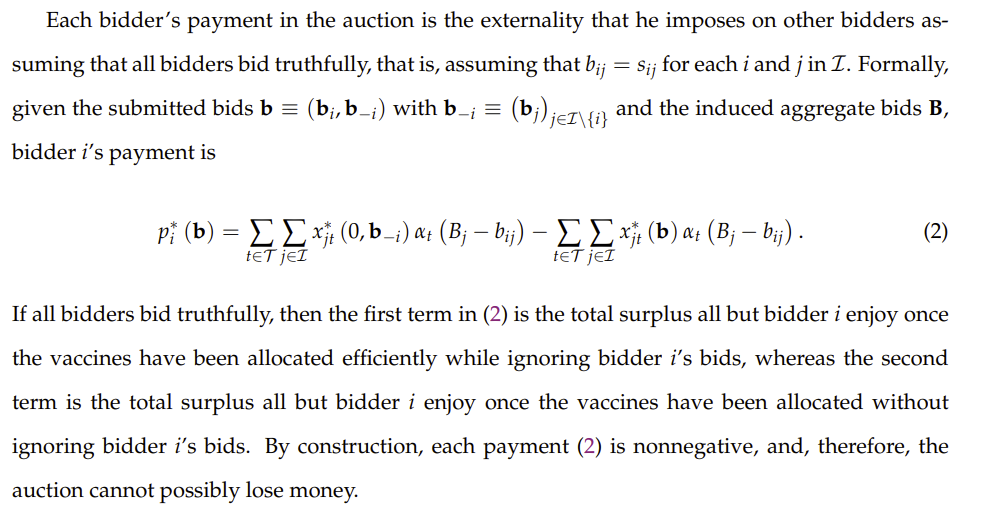
Which is exactly why no one wants to participate in auctions or read economics papers. I believe that the paper’s approach boils down to “everyone writes down how much they value each person getting the vaccine at each possible point in time, drawing that curve for everyone” and then the auctioneer solves for the best possible solution that maximizes surplus, and everyone pays the marginal cost imposed on others behind them, as measured by how much they don’t want to wait one more slot to get their vaccine.
Which, I mean sure, that’s technically correct of course, the best kind of correct, but it’s also making my brain hurt reading it and that’s despite intuitively knowing the answer the moment the question was asked. No one is going to want to think about let alone write down full utility curves, the practical cost would be enormous.
And getting people in the wrong spot in line by a little bit is at worst a small mistake, and also not that meaningful given the logistics of vaccine administration. The vaccine is not exactly being teleported around.
Thus, I’m pretty sure in practice this reduces to ‘find the price that mostly clears the market and charge that price, then adjust it to keep clearing the market.’ The whole thing where others can bid on your behalf is how ‘people can buy things with dollars’ works already.
In response to the people saying ‘but poor people are poor and rich people are rich, you bastards’ they say the following:
This is, essentially, distribute a valuable asset according to politics, then allow trade. Which is a worse version of full free trade, since it involves political reallocation of wealth and (as noted by Myerson) results in a lot of profitable trades not happening because of various frictions, and also makes people feel bad about not selling their vaccine dose and also about selling their vaccine dose, because choices are bad. It seems obviously better than allocating via politics alone, since most of the trades that happen will be hugely profitable to both sides – the person selling will get a payment much, much bigger than they’d have found necessary, and the person buying will pay much, much less than the amount they value the vaccine. The ZOPA (zone of possible agreement) here is mostly huge. I have a hard time imagining that choices being bad overcomes that.
What I personally would love is a form of abstract that is “the paper that we would have written if we were only trying to get the central point across and didn’t care about formal anything at all.” Not quite You Have About Five Words (I keep thinking the ‘have’ is ‘get’ and having to correct myself, maybe the title should change) but mostly not that much more than that. A one-page Econ 101 cheat sheet can cover actual everything the class teaches, and most economics papers have at most one paragraph of actual information.
Here, it sure seems like the whole paper boils down to “Standard auction theory applies here.”
It usually does.
This, for example, is a great use case. Not Covid-19 related or in any way essential, but pretty great.
Another modest proposal is to fix the prices and then let people pay them, skipping over the auction as such, so we know we can raise $50 billion dollars for vaccine production and distribution (and motivation, shall we say) by letting a few people skip the line. That makes it easy to see it’s an absurdly good deal, but also either wouldn’t get enough takers or is leaving a lot of money on the table, in exchange for being easy to think about.
Also, that post points out something that seems important. What could be a better way to motivate people wanting the vaccine, than to show our richest, most famous and most powerful people paying really big bucks to get the shot a few months sooner?
The Chosen Alternative To That Auction
Meanwhile in vaccine prioritization via politics and power might occasionally have some issues news (Twitter video link to protesters protesting during meeting, and thread):
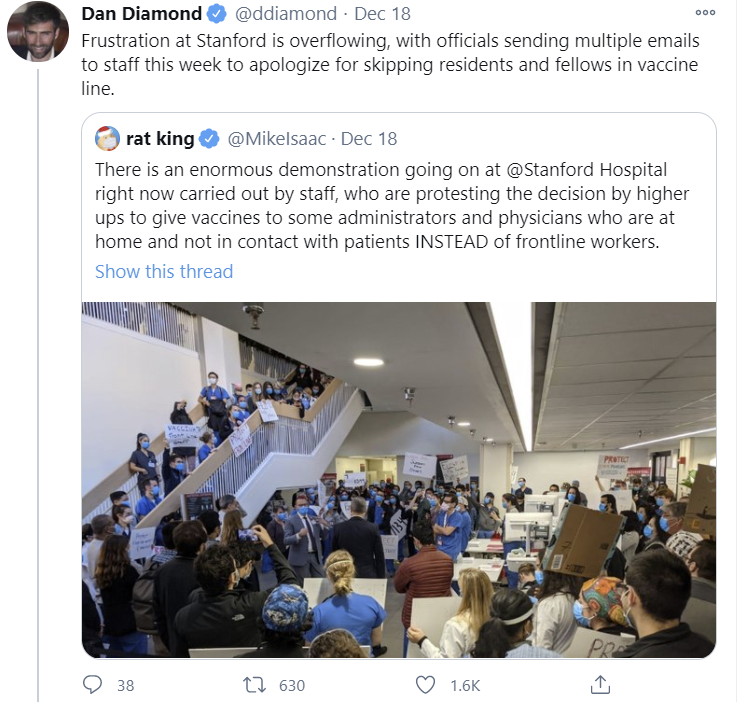
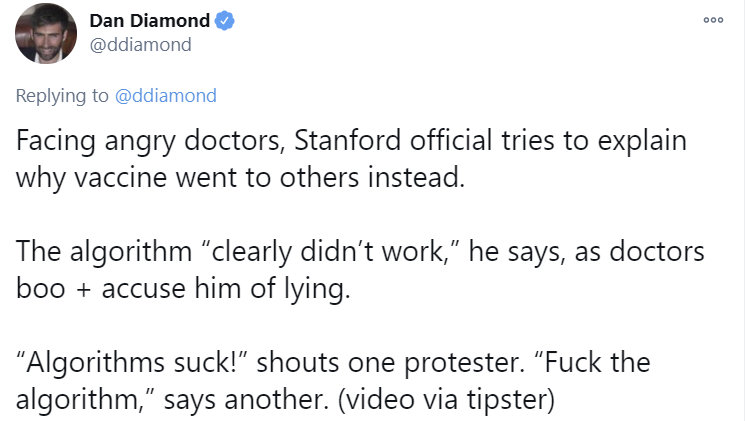
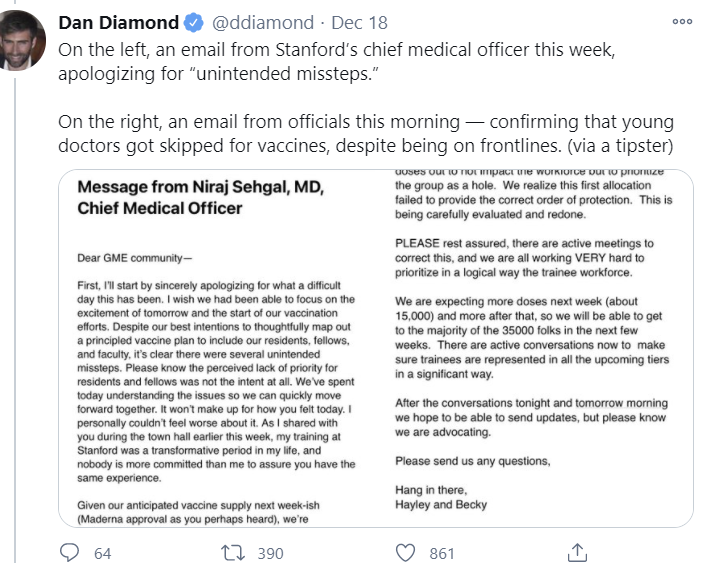
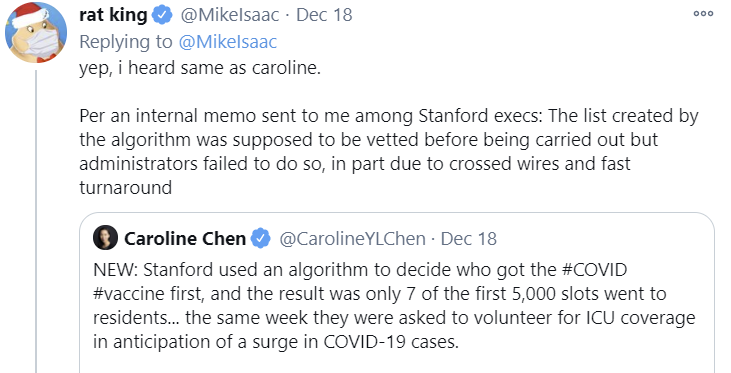
If I am interpreting this correctly, those with power used politics to get vaccinated first, ahead of nurses and residents. Residents, of course, are indentured servants giving four years of work under terrible conditions with hugely below market pay in exchange for the right to join a monopolistic guild that enforces scarcity of health care provision via government restrictions on supply of residences and slots in medical school.
This is exactly how political distributions of goods always go, except that this time it was a really bad look to give administrators in offices the vaccine before doctors who were actually treating Covid-19 patients. That’s what “The list created by the algorithm was supposed to be vetted” means here, that they were supposed to do a check to make sure their naked appropriation of vaccine had some plausible deniability attached at some level, whereas it turned out it didn’t.
But of course, as the thread points out, blaming ‘the algorithm’ or saying ‘there are problems with the algorithm’ is the obvious nonsense. Yes, there was a ‘problem with the algorithm’ and the ‘problem’ was ‘the people with power over the contents of the algorithm gave themselves top priority.’ This wasn’t some complex calculation. It didn’t involve machine learning. The result wasn’t surprising to anyone who came up with the criteria. The criteria was giving resources to the powerful rather than the powerless, via deeming them more ‘important’ or ‘vital’ or something.
This time, thankfully, they got caught. Yet they still got their vaccine shots.
Thus, this apology is the height of hypocrisy:
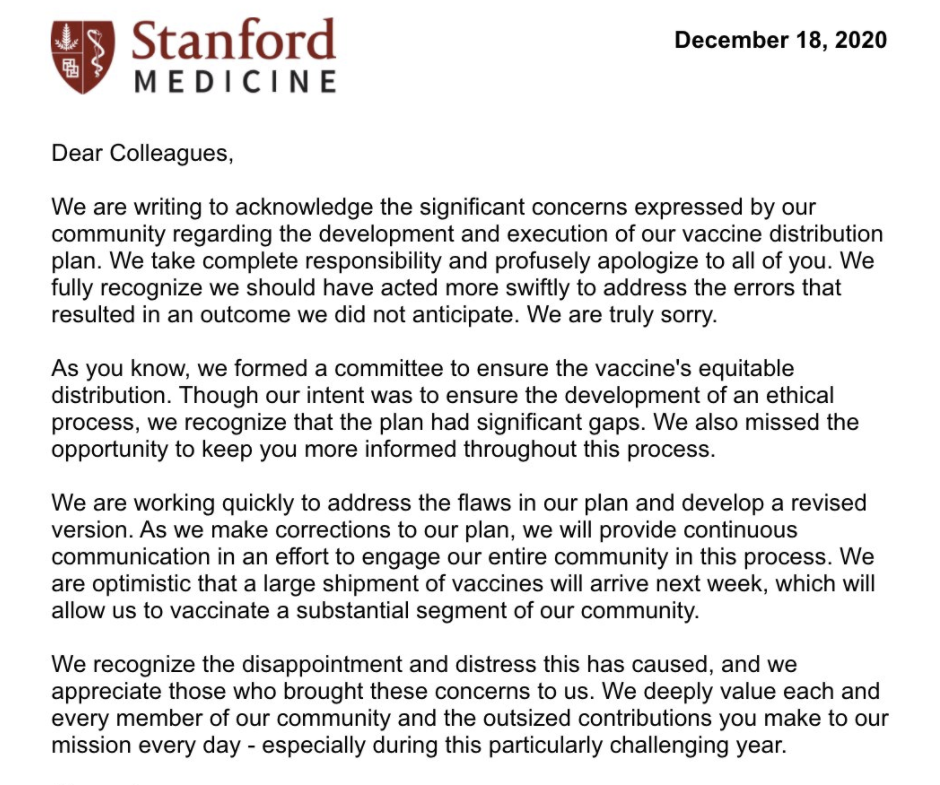
Did not anticipate, you say. Equitable distribution, you say. In case you ever wonder what equitable distribution means when those with power say it, now you know.
You gotta love the line “Though our intent was to ensure the development of an ethical process, we recognize that the plan has significant gaps.”
There’s also this:
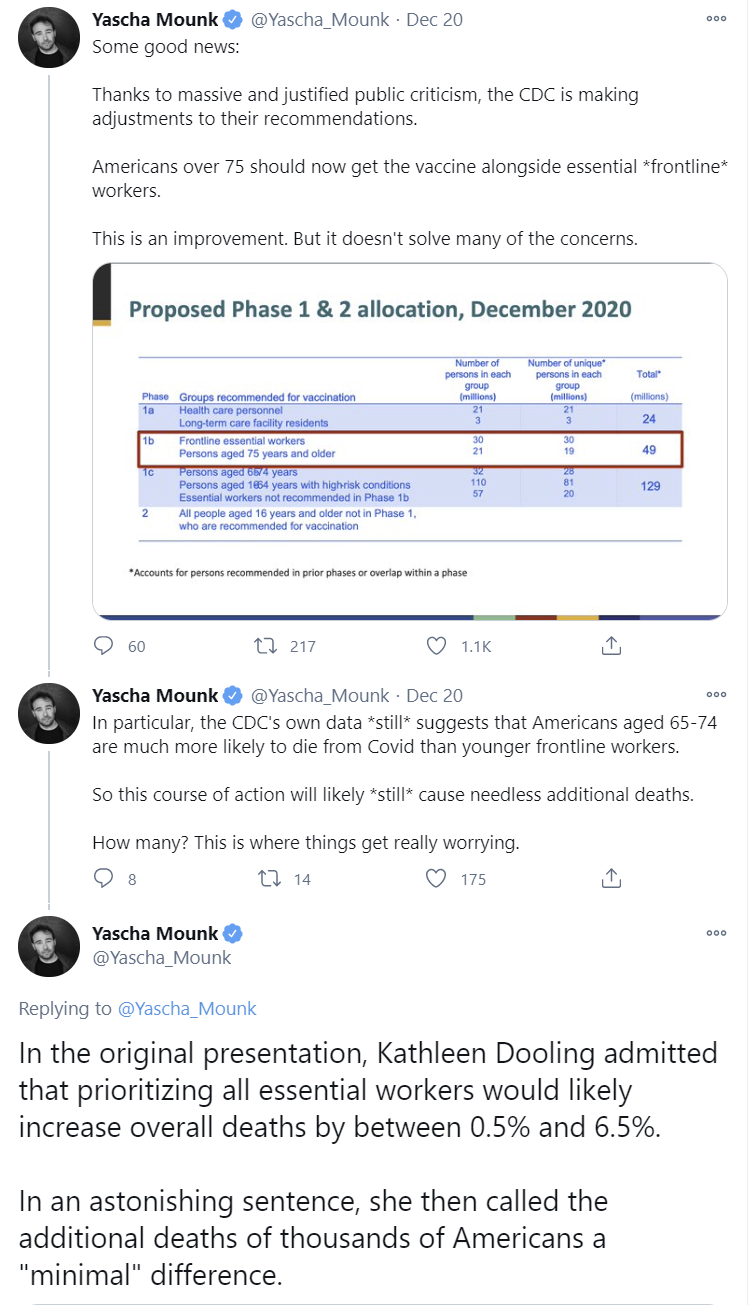
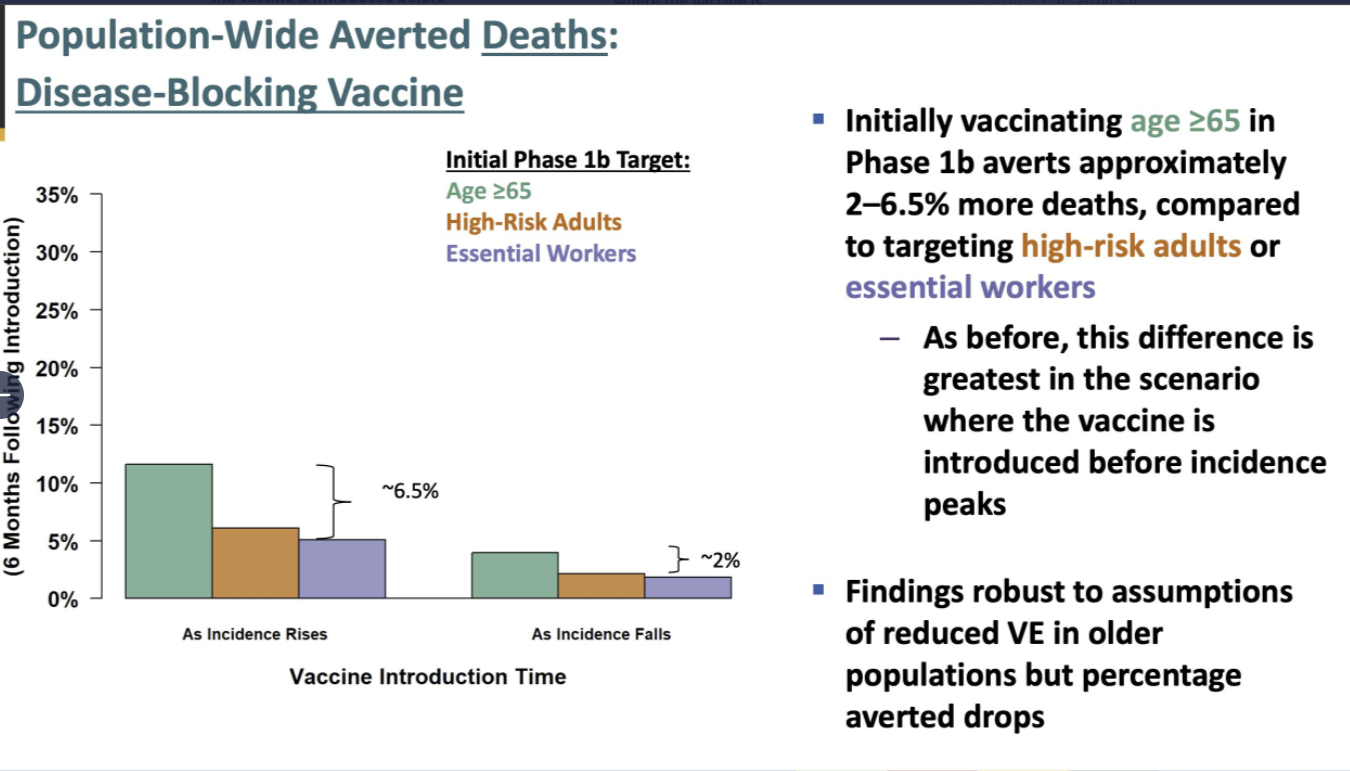
Also, I’m not going to link to any of the sources for this (to avoid heat vs. light and toxoplasma of rage issues, among other reasons), or offer a hot take on it, but there are a lot of “experts” and “ethicists” who have stated outright that we shouldn’t prioritize older people over younger people because older people are disproportionately white, so giving vaccine priority to the people most likely to die from Covid-19 is racist.
It is unclear to me to what extent this is driving policy decisions, but it seems like it came close to happening, with the CDC only reversing after a public outcry. The mayor of New York has endorsed this perspective explicitly.
So. Yeah.
But congratulations to Texas, among others (via CNBC):
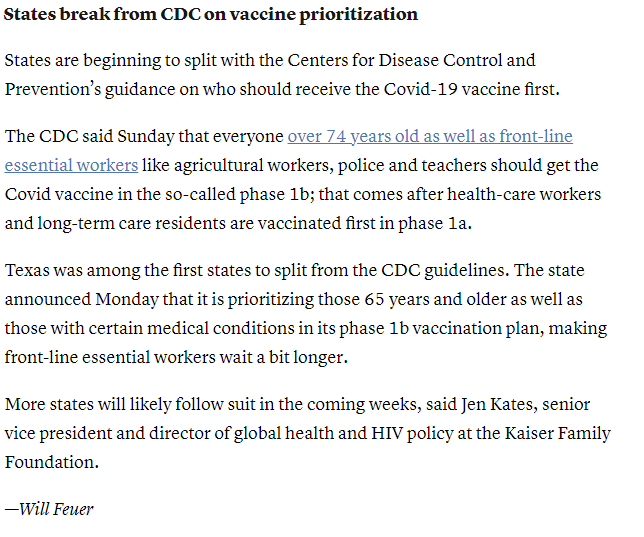
Face Saving
Kerry gets it, a thread I will post here in full:
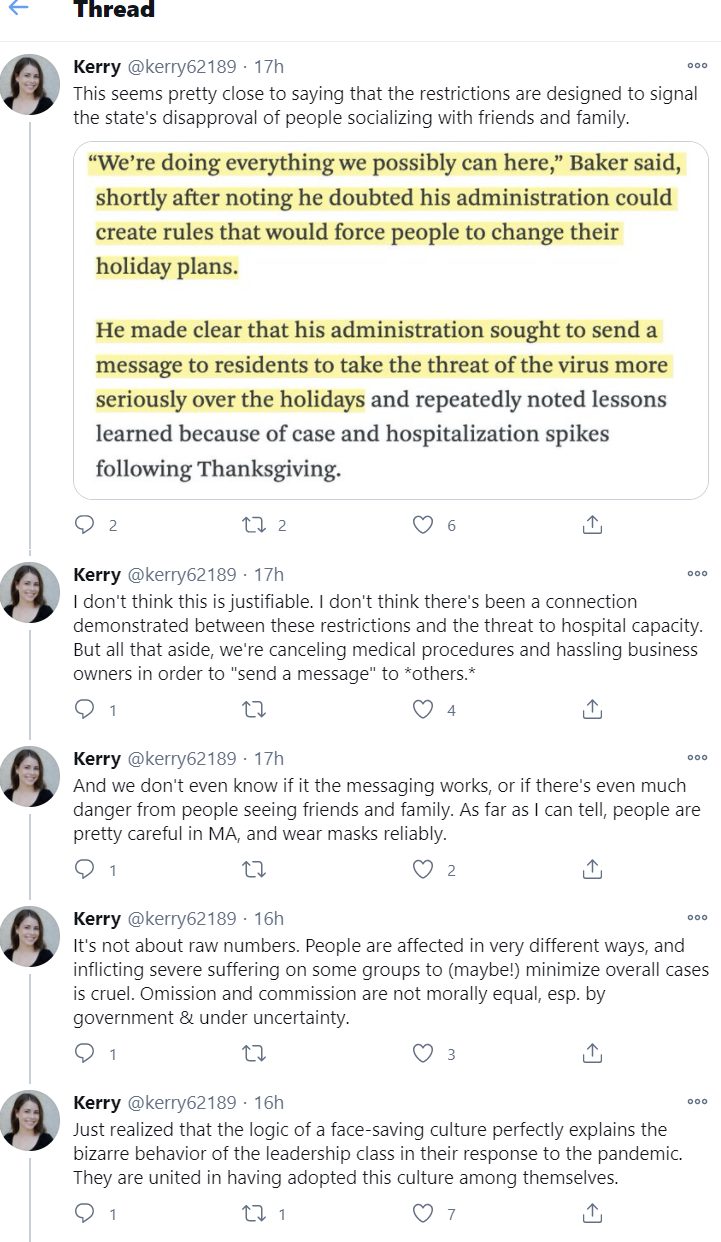
The government anticipates that people will not Act Responsibly on Christmas, and thus is pre-emptively punishing them in order to send a message.
What’s interesting is her proposal that we can understand such acts by the Very Serious People as being primarily about face.
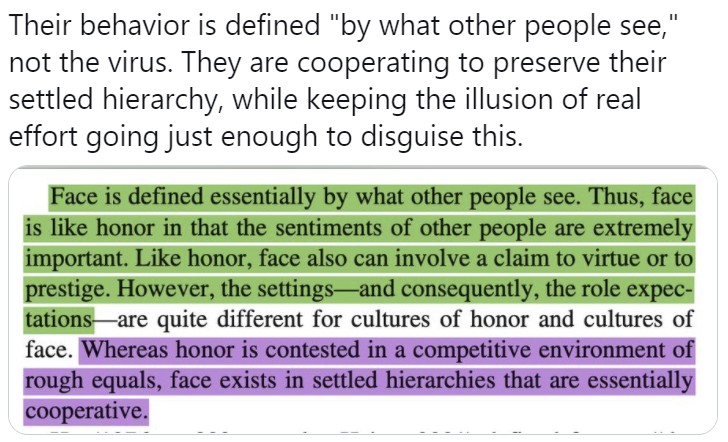
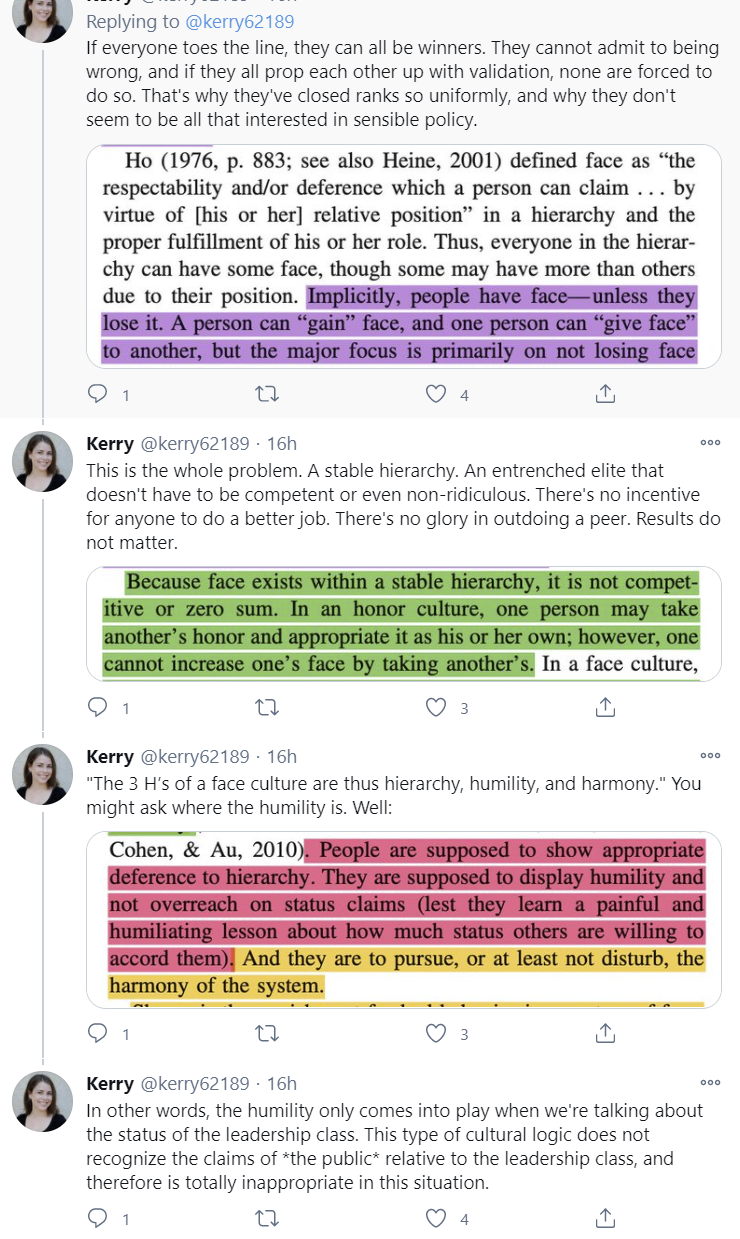
This reaches many of the same conclusions and makes many of the same predictions as many of the models and gears I’ve been using, but seems importantly different in ways that require more attention. These dynamics have been mostly left out of my models, and that seems like it might have been a mistake.
I am going to think more about whether it makes sense to incorporate such dynamics more centrally.
Quest for the Test
The good news is a $5 paper test strip has been approved by the FDA for home use. Of course, doing so legally will require an additional $25 so a digital MD service can watch you do it, which also means all sorts of coordination problems and activation energy and having to be observed by medical people silently judging you. Because of the need to beware trivial inconveniences it seems like the additional costs will be hugely destructive of the potential value here, although massive value should still remain.
Perhaps the next one will do better? As usual there’s claims it is coming Real Soon Now:
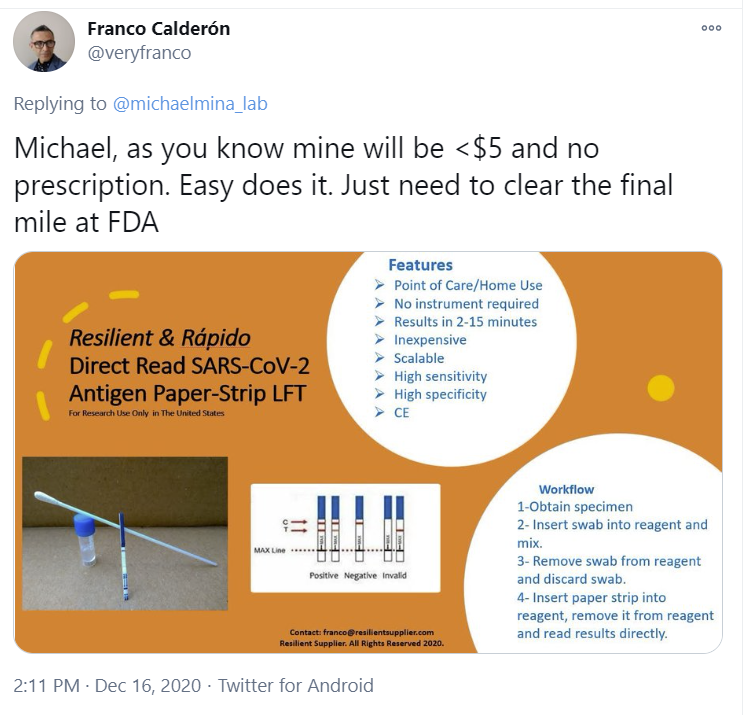
Alas I expect that last mile to find a way to at least inflict a lot of damage, even if cleared.
Whereas this plan from Canada seems awesome, taking the methods of continuous rapid testing that worked in some universities and applying them more generally to businesses that value being open.
And that’s this plan from Wisconsin:
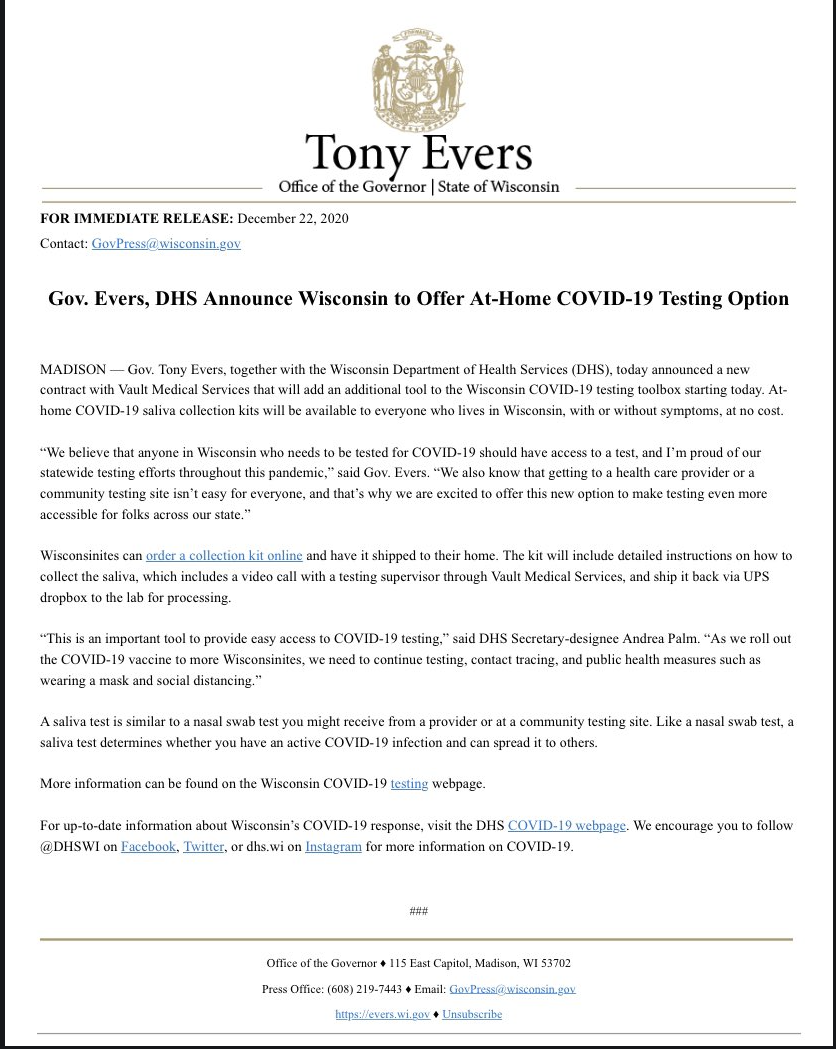
Free testing on demand, sample collection at home, even if it isn’t rapid, and even if they require a zoom call during the sample collection. And you need an email for each of your children, even if they’re two weeks old. Still. That’s not bad!
A sign they do not understand the proper goal of testing is that they don’t grok that people might want to do this periodically without any particular reasons to worry:

Another sign is, look for the mysteriously missing question on this FAQ list:
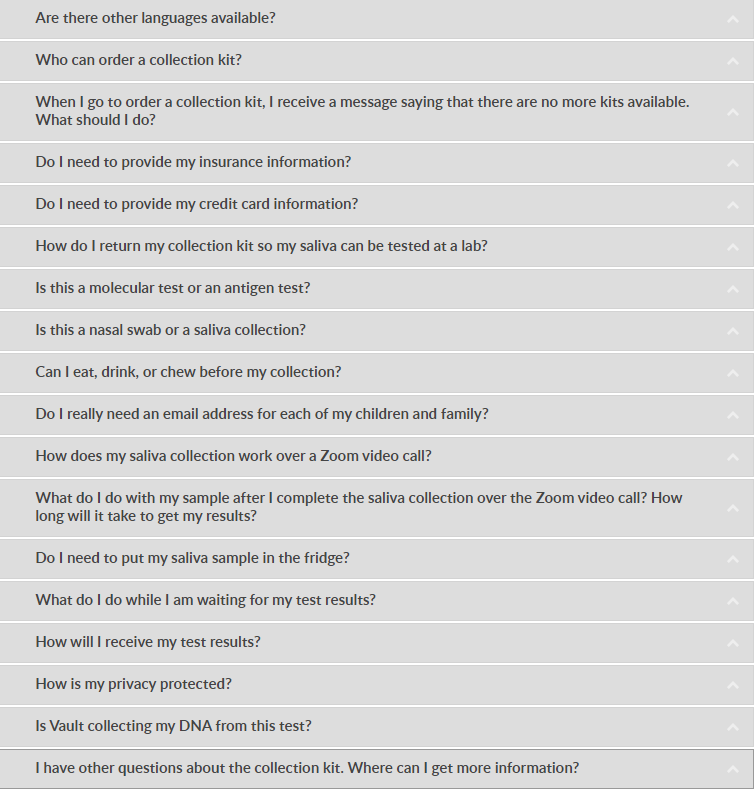
Oh yeah, that question. How long until I get my test results?
Good question!
In Other News
This analysis of how Covid-19 spreads seems excellent as far as I can tell, making a strong case that it’s mostly or entirely aerosol transmission, and that this fits the observed data fine, thanks. People I respect led me to it and also had the same take. If there’s anything wrong here, please speak up.
CDC issues the following guidelines and it only took until (checks calendar) December 21:

Any further questions? Never fear, they have an FAQ.
Also, yes, air ducts can almost certainly spread the virus, and six feet is not a magic number.
If you’re looking for treatments, this Quora response seems to be a real attempt at providing guidelines one could use. As usual I’m going to tread lightly on the treatment side and not take a stand.
Not a metaphor: Yes, you literally have to report as a ‘severe adverse event’ requiring investigation when someone in your vaccine trial is struck by lightning:

Official in Buffalo gives press conference announcing 60 people died, reporters only ask questions about the division champion Buffalo Bills. Official then tells them to ‘get their priorities straight’ but their priorities are already quite straight. The reporters know there’s a lot of deaths, and a lot of Covid-19, but what is the actionable information about that, that the official could tell them, that they don’t already know? What impacts people’s lives? The team could be in an unknown amount of trouble, and that matters to people in Buffalo. Whereas barring a change in policy that would have already been announced, they know exactly how screwed they are personally, and what they have to do. The true objection here is that when people are dying it’s wrong to not waste one’s time showing one’s concern about that and instead care about “trivial” things like the thing most or at least many people in Buffalo have cared most about the last few months. Or years.
Is using the bathroom essential? Second worst person Mayor De Blasio’s administration decided that it was not:

When a predictable uproar followed, he laid the blame on actual worst person Governor Andrew Cuomo, and requested that they gracefully allow New Yorkers to use indoor plumbing, a request that it seems has been granted:
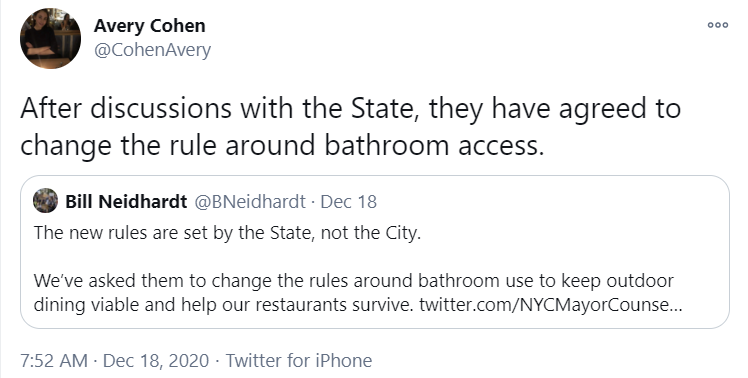
Also, among other rules, employees cannot drink alcohol under any circumstances, which seems rather cruel except for the part where they never enforce it. Right now I bet a lot of them could use a drink.
This seems to be what you get when you shut everything down for months and months on end:
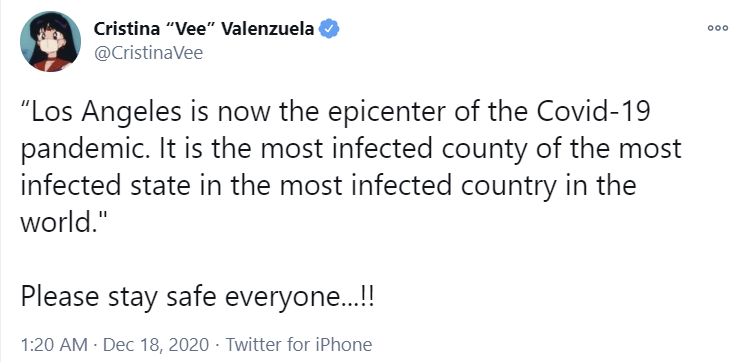
Why It Took So Long for the Army to Make Masks. The army masks are cloth masks with the right color scheme and symbols. That’s it. They are now getting around to being able to make them. The money quote for me is this:
According to the Army:
The CCFC was designed, developed, and produced along an expedited timeline. It normally takes 18–24 months for DLA (Defense Logistics Agency) to have the item available for order once the technical description, design, and components are approved and submitted. The CCFC, from inception to issuance, is slated to take less than one year.
The army is bragging that they figured out how to make masks this fast.
If there is a war, perhaps someone should tell the army. Seems like information they would want to know.
No news in the latest comparison of the Pfizer and Moderna vaccines. Bottom line is, they’re the same, except Moderna’s logistics are better.
Would I accept the Chinese vaccine? I mean, yes, I still think it’s better than nothing, but wow do they continue to be bad at science in a way that seems almost intentional:
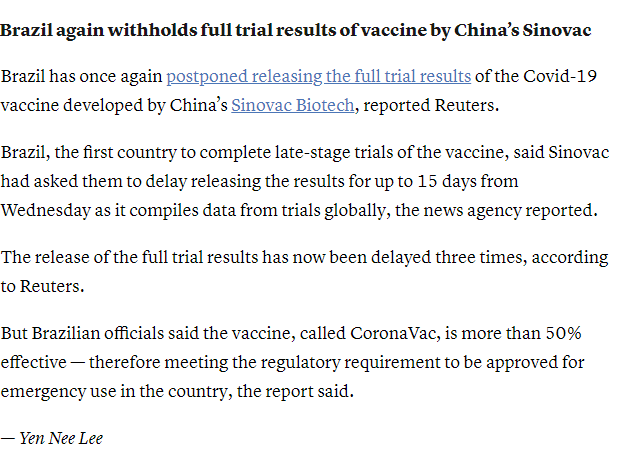
I know you think you’re helping but maybe just send paid time off?:

Not Covid, rather about hearing aids, once more with feeling: FDA Delenda Est.
Not Covid: MIRI gives its yearly research update. Disappointing to learn that research they couldn’t talk about didn’t pan out, and also disappointing that they still can’t talk about what it was, especially given hopes that the ideas might still have merit. Good to know they are willing to pivot to other different things and aren’t going to either keep going down a known blind alley or joining the gradient descent crowd. Also great to hear they are considering fleeing Berkeley, which I strongly endorse doing almost no matter the destination. Would love to do some coordination on that, but I’d definitely settle for the New Hampshire scenario, which I think would greatly enhance their ability to think.
Also not Covid, Other LessWrong news: The 2018 review is ongoing, but not many reviews are being written. I’d encourage those who qualify to help change that. I’m especially curious to hear people’s takes on my nominated posts.
Universal, the cult of the expert as explained by the Washington Post freelancer system:
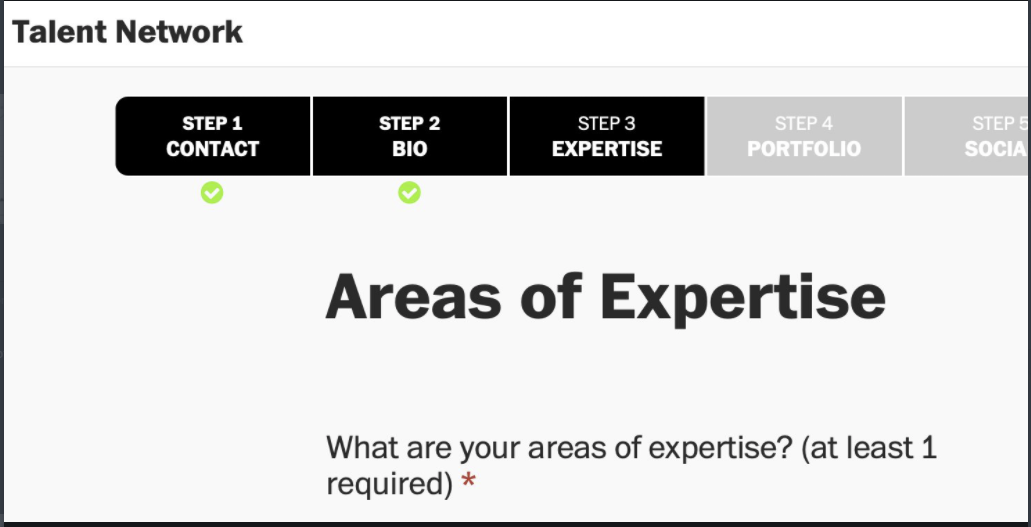
America’s finest news source weighs in on what snow days are for. And a reminder via Marginal Revolution, from the last pandemic, of what school is for and what happens when you cancel it.
What Happens Now?
There are many unknowns that have a dramatic effect on the path forward, and how the endgame plays out.
A few big ones dominate.
I do not see it as plausible that the new strain is confined to England. It has already been seen in several other nations, and the numbers in England are not compatible with it not being essentially everywhere already. It’s still right to cut off flights and travel now to slow things down, but the barn door is already wide open.
The biggest question is, instead, is the new English strain (or another similar strain like the one found in South Africa) really 65% more infectious as measured by infections per infected individual?
If that number is greatly exaggerated, then the strain will take a lot longer to get to where it matters, and even when it does the control systems and vaccinations can keep things mostly in check, and we are still on something not too different from the previous track. My guess is that aside from England itself, we could mostly deal with about a 33% more infectious strain given our timetable before it does that much damage.
If the 65% number is accurate, however, we are talking about the strain doubling each week. A dramatic fourth wave is on its way. Right now it is the final week of December. We have to assume the strain is already here. Each infection now is about a million by mid-May, six million by end of May, full herd immunity overshoot and game over by mid-July, minus whatever progress we make in reducing spread between now and then, including through acquired immunity. Which will help somewhat, but likely only buy a few weeks at most.
One worry I have is that the control system could actively make things worse between now and then, and accelerate the timeline. By the end of January, we should see up to a one third drop in the death rate purely from protecting nursing home residents, and then it will drop further as we protect other elderly people. If as I suspect the control system mostly acts on the death rate, they will use this as a reason to loosen and take more risk, and infection numbers will rise, or not fall the way we would have otherwise expected.
Then once the new strain arrives, it will be like March and April 2020, where by the time the deaths start spiking it is very late in the game, and there have already been three or more additional doublings.
The good news is that when this happens, most of our most vulnerable will have had the opportunity for vaccination. Assuming most of them take it, the (need for) hospitalization rate should be dramatically lower, and the IFR should also be dramatically lower if the hospitals don’t collapse. The hope is that with enough of the vulnerable protected, even a gigantic surge in cases might not collapse the system.
That’s the hope. It is basically the best (realistic) case scenario. It seems to be too late to speed up vaccine production much, although I see some reports Joe Biden is considering using the Defense Production Act to do so, in which case why the hell aren’t we doing whatever it takes to get that happening already? Have we considered throwing relatively tiny amounts of money at the problem? Maybe not quite that relatively tiny? No? Oh well. But I digress.
On the good news front, our tests still mostly seem to work fine for the new strain, although there is some small worry.
There is the concern that the vaccine might not be effective against the new strain, but based on my looking into this, the prior on there being much effect here should not be so high, except insofar as the new strain is more infectious so everything will be somewhat less effective at preventing spread. But if the virus has escaped from the vaccine already while also becoming more infectious, the timeline does not allow us to adjust even if we acted correctly, let alone acting realistically, the best we can hope for is maybe to protect some of the most vulnerable but I do not expect a Biden administration to allow movement fast enough to do that in this scenario. Instead, we’d see completely overwhelmed medical systems across the country, and that would be that.
On the potentially very good news front is the other big question. Is the new strain less virulent (dangerous) than the old one, and if so by how much?
I don’t think this is a favorite to be true, but I do think there’s a substantial chance (30%?) that it is, and we should investigate. All the news reports say that there’s no reason to expect that the mutation is more dangerous, which is true, but also not the change one would expect to often happen. The real question is whether it is now less dangerous, and for now the answer is we don’t know. If the effect size is big we will presumably figure this out by the end of January. Keeping an eye on England’s IFR will be important.
There are plausible physical mechanisms that suggest that some of these mutations may have led to less virulence. One piece of evidence that the strain is less virulent is that it is more infectious! Being less virulent causes it to be more infectious, so if the strain is more infectious, there’s a decent chance part of that was caused by less virulence.
Note that if we do face that scenario in the fourth wave, unless virulence has gone down quite a bit, you now face an even more stark version of what you did preparing for the third wave.
If we are in this scenario, it is inevitable that there will be a several week period, at a minimum, in which it is super easy to catch Covid-19, with a super infectious strain everywhere, and at a time when there will be no hospitals to help you, and no vaccine that works.
In that scenario, actually protecting yourself becomes vital if you haven’t been infected by the time the climax is approaching. As in essentially not being anywhere near a human outside your bubble, for weeks on end, at least until the hospitals stabilize.
It also becomes realistic again to worry about our supply chains or civil disorder. I expect everything to hold, but that can’t be assumed.
Then there’s the other nightmare. When this starts to happen, how will the authorities react?
Benevolent authorities would be responding now by making every attempt to speed up our vaccine efforts, and to prioritize the most vulnerable while we can. But if we had such benevolent authorities, they would have already been doing that. When something goes from super overdetermined to super duper overdetermined, it’s not generally the time to expect people to suddenly come up with the right answer when they didn’t before. Still, there’s some hope that this would happen, as the ‘don’t let it get so bad they sell out of pitchforks’ mechanics kick in. The other problem, as I’ve noted, is that there is not that much room to move faster without much more aggressive disregarding of barriers put in to prevent action, which would cause a ton of cognitive dissonance, and is not Biden’s style.
The question is what our actual, present authorities will do.
Like England, they might go for a full ‘lockdown.’ My assumption is that if they do this, people will end up largely ignoring it, and it won’t be enforced. There’s no will to make real restrictions stick even in blue tribe areas, and red tribe areas would be in open revolt, especially when it comes from a Biden administration. People have had enough, and they’ll have been told the story of how things were supposed to be returning to normal.
And even when they do that, they’ll still provide enough loopholes that it presumably wouldn’t work even if people didn’t go into open defiance of the rules.
Still, will they try anyway, doing epic additional economic damage and potentially causing open conflict? I worry about this a lot.
Thus, I don’t know if one should buy stocks or sell stocks on this, or even if one should buy volatility on this or not. If things crest once more and then burn out, that is not bad for stocks. It’s only bad if we get a dramatic response, which wouldn’t help the problem much but also give us a whole additional set of problems. We need to get ready, now, to do what we can to stop this from happening when the moment arrives, if the moment arrives. Sure, if it worked one could argue in favor, but the math seems rather clear that it won’t do any good. When politicians start trying to make it to next week without taking blame, and attempt to destroy everyone’s lives to do it, we need to find a way to stop them.
Or we could figure out how to make our efforts actually work. It’s not impossible. Is there still time to get our house in order and deal with this head on, if we want to? Hell yeah. But we can’t do it by Sacrificing to the Gods and taking sledgehammers to everything people like doing. We can’t even do it via doing that and being willing to shut down economically important activity, not for long enough to work. I’d be pleasantly surprised if we could even stabilize growth rates that way, and it’s completely unsustainable.
What we could do is prepare a testing regime now. Have that in place a few months from now, for real, and do the kind of testing on everyone that some universities do with their students. If we took all the regulatory gloves off, my guess is we wouldn’t even have to subsidize to get there on time. Add in proper focus on Vitamin D, airflow, outdoor activity and so on. We could still make it, and it would be an essentially free action.
We could probably start this on January 20 and still make it.
To be clear: We won’t attempt to do this, and it won’t happen. But it’s important to note that we still could, in at least some sense, still win, while also noting that we will lose. You never know. Maybe someone, somewhere, is actually listening.
In summary, I am attempting here to do now what I failed to do in December or January, which is to actually model what happens next based on exponential growth and realistic reactions by authorities.
My guess is that the English strain is probably sufficiently infectious to get there before enough vaccinations can happen to let realistic measures contain the pandemic. Right now I’m giving the strain something like a 70% chance to be sufficiently infectious, and if it is, I don’t see a way around this outcome.
This has counterintuitive implications, both for public policy and for individuals. As always, one’s approach to the pandemic must be to either succeed if one can do so at a cost worth paying, or fail gracefully if one cannot succeed. Thus, one could plausibly either make the case for being even more careful in response, or to folding one’s hand entirely. You can raise, or you can fold, but you can’t play passive and call all bets and hope to go to showdown.
It’s also important to figure out whether the new strain is less virulent than the old one, and if so to what extent, since that could change the math on sensible courses of action quite a bit. I haven’t fully wrapped my head around the implications, and I doubt many others have either. Simply saying it is “good news” does not begin to cover how this changes correct actions.
Let’s actually engage with the physical situation and model out what happens, and learn from last time out’s mistakes.
UPDATE 7/21/2021:
As you doubtless know at this point, it was not over. Given the visibility of this post, I'm going to note here at the top that the prediction of a potential large wave of infections between March and May did not happen, no matter what ultimately happens with Delta (and the prediction was not made with Delta in mind anyway, only Alpha).
I've talked extensively about the situation across many other posts, but for visibility I'm going to summarize my view of what happened here.
First, the early reports said that Alpha (this post calls it the English Strain, which is now called Alpha) was 65% more infectious than baseline. Instead, it looks like Alpha was about 40% more infectious. I noted that on our timetable, we could deal with about a 33% more infectious strain under the predicted-at-the-time vaccine timetable before major damage was done.
Second, when I was writing this post, I expected vaccine deployment to be substantially slower in its first few months than it ultimately was. I made a clear mistake not making this assumption explicit, but we got a lot more shots into arms that I expected during this period - I was thinking 100 million shots in 100 days (e.g. Biden's stated goal) and we did substantially better than that.
Together, these two incorrect assumptions explain why the wave did not occur, although they alone are insufficient to explain why things continued to improve so rapidly. My guess is that I was also somewhat underestimating seasonality, and that Alpha scared people sufficiently that the control systems acted differently than they otherwise would have, which also should have been considered more.
I gave the headline scenario about a 70% chance of playing out. It didn't play out, and the above reasons are why (in my current model) it failed to play out, and how I put a 70% probability on something that didn't happen.
Looking at what did happen, if we had indeed been facing a 65% more infectious strain at that time rather than 40%, we would have faced a wave of some size even with the other factors being better than I anticipated, but not the size of wave I was predicting; it would have taken a number more like 75% to cause a crisis before vaccinations could kick in. On reflection, given what I knew at the time, if we take the distribution of possible properties of the Alpha strain as a given, I think I should then have been predicting more like 40%-50% chance of the scenario rather than 70%.
Contrasting the situation with Alpha, where I thought it was at 65% more infectious than baseline and that it would cause a large wave before we could sufficiently vaccinate with Delta, where it's perhaps 120% more infectious than baseline but we've already done a lot of vaccinations, and now we are seeing rises in cases, is interesting, and will be an interesting test of whether the other assumptions I was making were accurate.


This article says it's worth watching but doesn't want to ring the alarm yet. It notes that the prior on mutations being bad is low, as there's been a lot of them with this virus. (H/T Alyssa Vance.)
Yes, the more people infected with the virus, and the longer the virus is in people the more time for a successful mutation to arise.